Geochronological, Geochemical and Sr-Nd-Hf Isotopic Studies of the A-type Granites and Adakitic Granodiorites in Western Junggar: Petrogenesis and Tectonic Implications
Abstract
1. Introduction
2. Geologic Background
3. Sampling and Analytical Methods
3.1. Zircon U-Pb Dating
3.2. Sr-Nd Isotope Analysis
3.3. Major and Trace Element Analyses
3.4. In Situ Zircon Hf Isotope Analysis
4. Results
4.1. Zircon U-Pb Ages
4.2. Major and Trace Element Composition
4.2.1. North Karamay Granitoids
4.2.2. Hongshan Granitoids
4.3. Sr-Nd-Hf Isotopic Composition
5. Discussion
5.1. Magmatism in the Western Junggar
5.2. Petrogenesis and Magma Source
5.2.1. North Karamay Granitoids
5.2.2. Hongshan Granitoids
5.3. Tectonic Implications
6. Conclusions
- The two studied granitoids from the Western Junggar can be classified as an adakitic granodiorite and an A-type granite. Both were emplaced in the period from 322–307 Ma.
- The adakitic granodiorites were likely generated from the partial melting of thickened lower crust. The A-type granites may have formed from partial melting of lower and middle crust in an intra-oceanic arc setting, where the melted material mainly consisted of oceanic crust.
- Slab rollback appears to have played an important role in the generation of arc-related igneous rocks, and in the continental growth of the Central Asian Orogenic Belt.
Author Contributions
Funding
Acknowledgments
Conflicts of Interest
References
- Hofmann, A.W. Mantle geochemistry: The message from oceanic volcanism. Nature 1997, 385, 219–229. [Google Scholar] [CrossRef]
- Wang, H.C.; Zhao, F.Q.; Li, H.M.; Sun, L.X.; Miao, L.C.; Ji, S.P. Zircon shrimp U-Pb age of the dioritic rocks from northern hebei: The geological records of late paleozoic magmatic arc. Acta Petrol. Sin. 2007, 23, 597–604. [Google Scholar]
- König, S.; Münker, C.; Schuth, S.; Garbeschönberg, D. The geochemical behaviour of Sb, Mo and W in subduction zones. Geochim. Cosmochim. Acta 2008, 72, A488. [Google Scholar]
- Chen, B.; Arakawa, Y. Elemental and Nd-Sr isotopic geochemistry of granitoids from the West Junggar Foldbelt (NW China), with implications for phanerozoic continental growth. Geochim. Cosmochim. Acta 2005, 69, 1307–1320. [Google Scholar] [CrossRef]
- Jahn, B.M. The central asian orogenic belt and growth of the continental crust in the phanerozoic. Geo. Soc. Lond. Spec. Pub. 2004, 226, 73–100. [Google Scholar] [CrossRef]
- Kay, S.M.; Mpodozis, C. Central andean ore deposits linked to evolving shallow subduction systems and thickening crust. GSA Today 2001, 11, 4–9. [Google Scholar] [CrossRef]
- Ramos, V.A.; Folguera, A. Andean flat-slab subduction through time. Geol. Soc. Lond. Spec. Pub. 2009, 327, 31–54. [Google Scholar] [CrossRef]
- Guivel, C.; Morata, D.; Pelleter, E.; Espinoza, F.; Maury, R.C.; Lagabrielle, Y. Miocene to late quaternary patagonian basalts (46–47° S): Geochronometric and geochemical evidence for slab tearing due to active spreading ridge subduction. J. Volcanol. Geotherm. Res. 2006, 149, 346–370. [Google Scholar] [CrossRef]
- Pallares, C.; Maury, R.C.; Bellon, H.; Royer, J.Y.; Calmus, T.; Aguillón-Robles, A. Slab-tearing following ridge-trench collision: Evidence from miocene volcanism in baja california, méxico. J. Volcanol. Geotherm. Res. 2007, 161, 95–117. [Google Scholar] [CrossRef]
- Von Blanckenburg, F.; Davies, J.H. Slab breakoff: A model for syncollisional magmatism and tectonics in the alps. Tectonics 1995, 14, 120–131. [Google Scholar] [CrossRef]
- Abratis, M.; Wörner, G. Ridge collision, slab-window formation, and the flux of pacific asthenosphere into the Caribbean realm. Geology 2001, 29, 127–130. [Google Scholar] [CrossRef]
- Guivel, C.; Lagabrielle, Y.; Bourgois, J.; Martin, H.; Arnaud, N.; Fourcade, S. Very shallow melting of oceanic crust during spreading ridge subduction: Origin of near-trench quaternary volcanism at the Chile triple junction. J. Geophys. Res. Solid Earth. 2003, 108, 457–470. [Google Scholar] [CrossRef]
- Geng, H.Y.; Sun, M.; Yuan, C.; Xiao, W.; Xian, W.; Zhao, G. Geochemical, sr-nd and zircon U-Pb-Hf isotopic studies of Late Carboniferous magmatism in the West Junggar, Xinjiang: Implications for ridge subduction? Chem. Geol. 2009, 266, 364–389. [Google Scholar] [CrossRef]
- Xiao, W.; Santosh, M. The western central Asian orogenic belt: A window to accretionary orogenesis and continental growth. Gondwana Res. 2014, 25, 1429–1444. [Google Scholar] [CrossRef]
- Kurasawa, H.; Konda, T. Strontium isotopic ratios of Tertiary volcanic rocks of northeastern Honshu, Japan: Implication for the spreading of the Japan Sea. J. Geol. Soc. Japan 1986, 92, 205–217. [Google Scholar] [CrossRef]
- Arai, H.; Yamamoto, A.; Matsuzawa, Y.; Saito, Y.; Yamada, N.; Oikawa, S. Polymorphisms of apolipoprotein e and methylenetetrahydrofolate reductase in the Japanese population. J. Atheroscler. Thromb. 2007, 14, 167. [Google Scholar] [CrossRef]
- Nohda, S.; Tatsumi, Y.; Otofuji, Y.I.; Matsuda, T.; Ishizaka, K. Asthenospheric injection and back-arc opening: Isotopic evidence from northeast Japan. Chem. Geol. 1988, 68, 317–327. [Google Scholar] [CrossRef]
- Tatsumi, Y.; Nohda, S.; Ishizaka, K. Secular variation of magma source compositions beneath the Northeast Japan arc. Chem. Geol. 1988, 68, 309–316. [Google Scholar] [CrossRef]
- Chin, C.D.; Linder, V.; Sia, S.K. Commercialization of microfluidic point-of-care diagnostic devices. Lab Chip. 2012, 12, 2118–2134. [Google Scholar] [CrossRef]
- Şengör, A.M.C. Some current problems on the tectonic evolution of the Mediterranean during the Cainozoic. NATO ASI 1993, 402, 1–51. [Google Scholar]
- Şengör, A.M.C.; Natal_in, B.A. Turkic-type orogeny and its role in the making of the continental crust. Annu. Rev. Earth Planet. Sci. 1996, 24, 263–337. [Google Scholar] [CrossRef]
- Yakubchuk, A. Architecture and mineral deposit settings of the altaid orogenic collage: A revised model. J. Asian Earth Sci. 2004, 23, 761–779. [Google Scholar] [CrossRef]
- Xiao, W.; Han, C.; Chao, Y.; Min, S.; Lin, S.; Chen, H. Middle Cambrian to Permian subduction-related accretionary orogenesis of Northern Xinjiang, NW China: Implications for the tectonic evolution of central Asia. J. Asian Earth Sci. 2008, 32, 102–117. [Google Scholar] [CrossRef]
- Xiao, W.; Huang, B.; Han, C.; Shu, S.; Li, J. A review of the western part of the altaids: A key to understanding the architecture of accretionary orogens. Gondwana Res. 2010, 18, 253–273. [Google Scholar] [CrossRef]
- Xiao, W.; Sun, M.; Santosh, M. Continental reconstruction and metallogeny of the Circum-Junggar areas and termination of the southern Central Asian Orogenic Belt. Geosci. Front. 2015, 6, 137–140. [Google Scholar] [CrossRef]
- Zhang, C.; Liu, D.D.; Zeng, J.H.; Jiang, S.; Luo, Q.; Kong, X.Y.; Yang, W.; Liu, L.F. Nd-O-Hf isotopic decoupling in S-type granites: Implications for ridge subduction. Lithos 2019, 332–333, 261–273. [Google Scholar] [CrossRef]
- Zhang, C.; Jiang, S.; Liu, D.D.; Chakrabarti, R.; Zeng, J.H.; Santosh, M.; Luo, Q.; Spencer, C.J.; Ma, C.; Liu, L.F.; et al. A novel model for silicon recycling in the lithosphere: Evidence from the Central Asian Orogenic Belt. Gondwana Res. 2019, 76, 115–122. [Google Scholar] [CrossRef]
- Zhang, C.; Liu, D.; Zhang, X.; Spencer, C.; Tang, M.; Zeng, J.; Jiang, S.; Jolivet, M.; Kong, X. Hafnium isotopic disequilibrium during sediment melting and assimilation. Geochem. Persp. Let. 2020, 12, 34–39. [Google Scholar] [CrossRef]
- Zhang, C.; Zhang, X.; Santosh, M.; Liu, D.D.; Ma, C.; Zeng, J.H.; Jiang, S.; Luo, Q.; Kong, X.Y.; Liu, L.F. Zircon Hf-O-Li isotopes of granitoids from the Central Asian Orogenic Belt: Implications for supercontinent evolution. Gondwana Res. 2020, 83, 132–140. [Google Scholar] [CrossRef]
- Chen, B.; Jahn, B.M. Genesis of post-collisional granitoids and basement nature of the Junggar terrane, NW China: Nd-Sr isotope and trace element evidence. J. Asian Earth Sci. 2004, 23, 691–703. [Google Scholar] [CrossRef]
- Windley, B. Chapter 1.1 overview and history of investigation of early earth rocks. Dev. Precambrian Geol. 2007, 15, 3–7. [Google Scholar]
- Xiao, W.J.; Windley, B.F.; Huang, B.C.; Han, C.M.; Yuan, C.; Chen, H.L.; Sun, M.; Li, J.L. End-Permian to mid-Triassic termination of the accretionary processes of the southern Altaids: Implications for the geodynamic evolution, Phanerozoic continental growth, and metallogeny of Central Asia. Int. J. Earth Sci. (Geol. Rundsch.) 2009, 98, 1189–1217. [Google Scholar] [CrossRef]
- Biske, Y.S.; Seltmann, R. Paleozoic Tian-shan as a transitional region between the rheic and urals-turkestan oceans. Gondwana Res. 2010, 17, 602–613. [Google Scholar] [CrossRef]
- Han, B.F.; Wang, S.G.; Jahn, B.M.; Hong, D.W.; Kagami, H.; Sun, Y.L. Depleted-mantle source for the ulungur river a-type granites from North Xinjiang, China: Geochemistry and nd-sr isotopic evidence, and implications for phanerozoic crustal growth. Geol. Chem. Miner. 1997, 138, 135–159. [Google Scholar] [CrossRef]
- Jahn, B.M.; Wu, F.Y.; Chen, B. Granitoids of the central asian orogenic belt and continental growth in the phanerozoic. Trans. R. Soc Edinb. Earth 2000, 91, 181–193. [Google Scholar] [CrossRef]
- Yuan, C.; Sun, M.; Xiao, W.; Li, X.; Chen, H.; Lin, S. Accretionary orogenesis of the Chinese Altai: Insights from Paleozoic granitoids. Chem. Geol. 2007, 242, 22–39. [Google Scholar] [CrossRef]
- Zhang, C.; Santosh, M.; Liu, L.F.; Luo, Q.; Zhang, X.; Liu, D.D. Early Silurian to Early Carboniferous ridge subduction in NW Junggar: Evidence from geochronological, geochemical, and Sr-Nd-Hf isotopic data on alkali granites and adakites. Lithos 2018, 300–301, 314–329. [Google Scholar] [CrossRef]
- Zhang, C.; Luo, Q.; Zhang, X.; Liu, L.F.; Liu, D.D.; Wang, P.F.; Yang, K.J.; Wang, J.; Zhao, Y. Geochronological, geochemical, and Sr-Nd-Hf isotopic studies of the Aketas adakitic granites in Eastern Junggar: Petrogenesis and tectonic implications. Geol. J. 2018, 5, 80–101. [Google Scholar] [CrossRef]
- Zhang, C.; Liu, D.D.; Luo, Q.; Liu, L.F.; Zhang, Y.Z.; Zhu, D.Y.; Wang, P.F.; Dai, Q.Q. An evolving tectonic environment of Late Carboniferous to Early Permian granitic plutons in the Chinese Altai and Eastern Junggar terranes, Central Asian Orogenic Belt, NW China. J. Asian Earth Sci. 2017, 159, 185–208. [Google Scholar] [CrossRef]
- Zhang, C.; Liu, L.F.; Santosh, M.; Luo, Q.; Zhang, X. Sediment recycling and crustal growth in the Central Asian Orogenic Belt: Evidence from Sr-Nd-Hf isotopes and trace elements in granitoids of the Chinese Altay. Gondwana Res. 2017, 47, 142–160. [Google Scholar] [CrossRef]
- Tang, D.M.; Qin, K.Z.; Sun, H.; Su, B.X.; Xiao, Q.H. The role of crustal contamination in the formation of Ni-Cu sulfide deposits in eastern tianshan, xinjiang, northwest China: Evidence from trace element geochemistry, Re-Os, Sr-Nd, zircon Hf-O, and sulfur isotopes. J. Asian Earth Sci. 2012, 49, 145–160. [Google Scholar] [CrossRef]
- Yang, G.; Li, Y.; Safonova, I.; Yi, S.; Tong, L.; Seltmann, R. Early carboniferous volcanic rocks of west Junggar in the western central asian orogenic belt: Implications for a supra-subduction system. Int. Geol. Rev. 2014, 56, 823–844. [Google Scholar] [CrossRef]
- Feng, Z.Z.; Chen, J.X.; Sheng, H. Lithofacies paleogeography of Early Paleozoic of North China Platform. Acta Sedimentol. Sin. 1989, 7, 16–55. [Google Scholar]
- Han, B.F.; Ji, J.Q.; Song, B.; Chen, L.H. Late paleozoic vertical growth of continental crust around the Junggar basin, Xinjiang, China (part Ⅰ): Timing of post-collisional plutonism. Acta Petrol. Sin. 2006, 22, 1077–1086. [Google Scholar]
- Zhou, T.; Yuan, F.; Fan, Y.; Zhang, D.; Cooke, D.; Zhao, G. Granites in the Sawuer region of the West Junggar, Xinjiang Province, China: Geochronological and geochemical characteristics and their geodynamic significance. Lithos 2008, 106, 191–206. [Google Scholar] [CrossRef]
- Tang, G.J.; Wang, Q.; Wyman, D.A.; Sun, M.; Li, Z.X.; Zhao, Z.H. Geochronology and geochemistry of late paleozoic magmatic rocks in the lamasu-dabate area, Northwestern Tianshan (West China): Evidence for a tectonic transition from arc to post-collisional setting. Lithos 2010, 119, 393–411. [Google Scholar] [CrossRef]
- Tang, G.J.; Wang, Q.; Wyman, D.A.; Li, Z.X.; Zhao, Z.H.; Yang, Y.H. Late Carboniferous high εNd (t)-εHf (t) granitoids, enclaves and dikes in Western Junggar, NW China: Ridge-subduction-related magmatism and crustal growth. Lithos 2012, 140–141, 86–102. [Google Scholar] [CrossRef]
- Tang, G.J.; Wang, Q.; Wyman, D.A.; Li, Z.X.; Xu, Y.G.; Zhao, Z.H. Recycling oceanic crust for continental crustal growth: Sr-Nd-Hf isotope evidence from granitoids in the Western Junggar region, NW China. Lithos 2012, 128, 73–83. [Google Scholar] [CrossRef]
- Chen, J.F.; Han, B.F.; Ji, J.Q.; Zhang, L.; Xu, Z.; He, G.Q. Zircon U-Pb ages and tectonic implications of Paleozoic plutons in northern West Junggar, North Xinjiang, China. Lithos 2010, 115, 137–152. [Google Scholar] [CrossRef]
- Zhang, F.; Zhang, Y.; Wang, D.K. Research Institute of Petroleum Exploration and Development, Company, S.O.; Geoscience, S.O. Identification of the lithology of Carboniferous and its reservoir characteristics in Chepaizi uplift, Junggar Basin. J. Southwest Pet. Univ. 2014, 36, 21–28. [Google Scholar]
- Yang, F.; Mao, J.; Pirajno, F.; Yan, S.; Liu, G.; Zhou, G. A review of the geological characteristics and geodynamic setting of Late Paleozoic porphyry copper deposits in the Junggar region, Xinjiang uygur autonomous region, Northwest China. J. Asian Earth Sci. 2012, 49, 80–98. [Google Scholar] [CrossRef]
- Didenko, A.N.; Morozov, O.L. Geology and paleomagnetism of middle-upper Paleozoic rocks of the Saur Ridge. Geotectonics 1999, 4, 64–80. [Google Scholar]
- Vladimirov, A.G.; Kruk, N.N.; Khromykh, S.V.; Polyansky, O.P.; Chervov, V.V.; Vladimirov, V.G.; Travin, A.V.; Babin, G.A.; Kuibida, M.L.; Khomyakov, V.D. Permian magmatism and lithospheric deformation in the Altai caused by crustal and mantle thermal processes. Russ. Geol. Geophys. 2008, 49, 468–479. [Google Scholar] [CrossRef]
- Zhu, Y.F.; Xu, X. The discovery of Early Ordovian ophiolite mélange in Taerbahatai Mts., Xinjiang, NW China. Acta Petrol. Sin. 2006, 22, 2833–2842. [Google Scholar]
- Geng, H.Y.; Sun, M.; Yuan, C.; Zhao, G.C.; Xiao, W.J. Geochemical and geochronological study of Early Carboniferous volcanic rocks from the west Junggar: Petrogenesis and tectonic implications. J. Asian Earth Sci. 2011, 42, 854–866. [Google Scholar] [CrossRef]
- Wang, R.; Zhu, Y.F. Geology of the Baobei Gold Deposit in Western Juggar and Zircon SHRIMP Age of Its Wall-Rocks, Western Junggar (Xinjiang, NW China). Geol. J. China Univ. 2007, 13, 590–602. [Google Scholar]
- Guo, L.S.; Liu, Y.L.; Wang, Z.H.; Song, D.; Xu, F.J.; Su, L. The Zircon U-Pb LA-ICP-MS geochronology of volcanic rocks in Baogutu areas, Western Junggar. Acta Petrol. Sin. 2010, 26, 471–477. [Google Scholar]
- An, F.; Zhu, Y.F. SHRIMP U-Pb zircon ages of tuff in Baogutu Formation and their geological significances. Acta Petrol. Sin. 2009, 25, 1437–1465. [Google Scholar]
- Jian, P.; Liu, D.Y.; Shi, Y.R.; Zhang, F.Q. SHRIMP dating of SSZ ophiolites from northern Xinjiang Province, China: Implications for generation of oceanic crust in the Central Asian orogenic belt. In Structural and Tectonic Corre-lation across the Central Asia Orogenic Collage: North-Eastern Segment; Guide Book and Abstract Volume of the Siberian Workshop IGCP-480: Irkutsk-Ulan-Ude; Sklyarov, E.V., Ed.; Institute of the Earth’s Crust of the Siberian Branch of Russian Academy of Sciences: Irkutsk, Russia, 2005; Volume 246. [Google Scholar]
- Xu, Z.; Han, B.F.; Ren, R.; Zhou, Y.Z.; Zhang, L.; Chen, J.F. Ultramafic-mafic mélange, island arc and post-collisional intrusions in the Mayile Mountain, West Junggar, China: Implications for paleozoic intra-oceanic subduction-accretion process. Lithos 2012, 132–133, 141–161. [Google Scholar] [CrossRef]
- Liu, X.; Xu, J.F.; Wang, S.Q.; Hou, Q.Y. Geochemistry and dating of E-MORB type mafic rocks from dalabute ophiolite in West Junggar, Xinjiang and geological implications. Acta Petrol. Sin. 2009, 25, 1373–1389. [Google Scholar]
- Chen, B.; Zhu, Y.F.; An, F.; Qiu, T.; Chen, Y.C. The discovery of spinel peridotite in Baikouquan area, Karamay, Xinjiang. Geol. Bull. China. 2011, 30, 1017–1026. [Google Scholar]
- Buckman, S.; Aitchison, J.C. Tectonic evolution of Palaeozoic terranes in West Junggar, Xinjiang, NW China. Geol. Soc. Lond. Special Pub. 2004, 226, 101–129. [Google Scholar] [CrossRef]
- Feng, Q.W.; Li, J.Y.; Liu, J.F.; Zhang, J.; Qu, J.F. Ages of the Hongshan granite and intruding dioritic dyke swarms, in Western Junggar, Xinjiang, NW China: Evidence form LA-ICP-MS zircon chronology. Acta Petrol. Sin. 2012, 28, 2935–2949. [Google Scholar]
- Jin, X.; Zhang, M.; Dong, G.S.; Zhu, X.G.; Xu, M.; Chen, Y. Preparation and structural study of metastable Mn phase grown on GaAs (OOI) substrate. MRS Proc. 1993, 326, 323. [Google Scholar] [CrossRef]
- Zhao, P.; Xu, B.; Tong, Q.; Chen, Y.; Faure, M. Sedimentological and geochronological constraints on the Carboniferous evolution of Central Inner Mongolia, South Eastern Central Asian Orogenic Belt: Inland Sea deposition in a post-orogenic setting. Gondwana Res. 2016, 31, 253–270. [Google Scholar] [CrossRef]
- Su, Y.P.; Tang, H.F.; Hou, G.S.; Liu, C.Q. Geochemistry of aluminous a-type granites along darabut tectonic belt in West Junggar, Xinjiang. Geochimica 2006, 35, 55–67. [Google Scholar]
- Kwon, S.T.; Tilton, G.R.; Goleman, R.C.; Feng, Y. Isotopic studies bearing on the tectonics of the West Junggar region, Xinjiang, China. Tectonics 1989, 8, 719–727. [Google Scholar] [CrossRef]
- Gao, S.L.; He, Z.L.; Zhou, Z.Y. Geochenmical characteristics of the Karamay granitoids and their significance in West Junggar, Xinjiang. Xinjiang Geol. 2006, 24, 125–130. [Google Scholar]
- Feng, Q.W.; Li, J.Y.; Liu, J.F.; Song, B.; Wang, Y.B.; Chen, W.; Zhang, Y. Ages and geological significance of the darkdykes emplaced in the Karamay pluton and adjacent area,in western Junggar, Xinjiang, NW China: Evidence form LA-ICP-MS zircon chronology and Ar-Ar amphibole chronology. Acta Petrol. Sin. 2012, 28, 2158–2170. [Google Scholar]
- Kang, L.; Li, Y.J.; Zhang, B.; Zhang, H.W.; Wang, J.N. Petrographic evidence for magma mixing of Xiaerpu granite in West Junggar, Xinjiang. Acta Petrol. Mineral. 2009, 28, 423–432. [Google Scholar]
- Liu, J.P.; Wang, H.; Li, S.H.; Tong, L.X.; Ren, G.L. Geological and geochemical features and geochronology of the Kayizi porphyry molybdenum deposit in the northern belt of Western Kunlun, NW China. Acta Petrol. Sin. 2010, 26, 3095–3105. [Google Scholar]
- Ludwig, K.R. Eliminating mass-fractionation effects on U-Pb isochron ages without double spiking. Geochim. Cosmochim. Acta 2001, 65, 3139–3145. [Google Scholar] [CrossRef]
- Zhang, Q.; Wang, Y.; Wang, Y.L. Preliminary study on the components of the lower crust in East China plateau during Yanshanian period: Constraints on Sr and Nd isotopic compositions of adakite-like rocks. Acta Petrol. Sin. 2001, 17, 505–513. [Google Scholar]
- Fang, W.; Yang, S.; Liu, Z.; Wei, X.; Zhang, B. Geochemical characteristics and significance of major elements, trace elements and REE in mineralized altered rocks of large-scale tsagaan suvarga Cu-Mo porphyry deposit in Mongolia. J. Rare Earth 2007, 25, 759–769. [Google Scholar]
- Hu, Z.C.; Liu, Y.S.; Gao, S.; Xiao, S.Q.; Zhao, L.S.; Günther, D.; Li, M.; Zhang, W.; Zong, K.Q. A “wire” signal smoothing device for laser ablation inductively coupled plasma mass spectrometry analysis. Spectrochim. Acta Part B 2012, 78, 50–57. [Google Scholar] [CrossRef]
- Liu, W.; Liu, L.J.; Liu, X.J.; Shang, H.J.; Zhou, G. Age of the early devonian Kangbutiebao formation along the Southern Altay mountains and its Northeastern extension. Acta Petrol. Sin. 2010, 26, 387–400. [Google Scholar]
- Defant, M.J.; Richerson, P.M.; De Boer, J.Z. Dacite genesis via both slab melting and differentiation: Petrogenesis of La Yeguada volcanic complex, Panama. J. Petrol. 1991, 32, 1101–1142. [Google Scholar] [CrossRef]
- Defant, M.J.; Jackson, T.E.; Drummond, M.S.; De Boer, J.Z.; Bellen, H.; Feigeson, M.D.; Maury, R.C. The geochemistry of young volcanism throughout western Panama and southeastern Costa Rica: An overview. J. Geol. Soc. 1992, 149, 569–579. [Google Scholar] [CrossRef]
- Defant, M.J.; Xu, J.F.; Kepezhinsksa, P.; Wang, Q.; Zhang, Q.; Xiao, L. Adakites: Some variations on a theme. Acta Petrol. Sin. 2002, 18, 129–142. [Google Scholar]
- Middlemost, E.A.K. Naming materials in the magma igneous rock system. Earth-Sci. Rev. 1994, 37, 215–224. [Google Scholar] [CrossRef]
- Maniar, P.D.; Piccoli, P.M. Tectonic discrimination of granitoids. Geol. Soc. Am. Bull. 1989, 101, 635–643. [Google Scholar] [CrossRef]
- Sun, S.S.; Mcdonough, W.F. Chemical and Isotopic Systematics of Oceanic Basalts: Implications for Mantle Composition and Processes. Geol. Soc. Lond. Spec. Publ. 1989, 42, 313–345. [Google Scholar] [CrossRef]
- Yin, J.Y.; Long, X.P.; Yuan, C.; Sun, M.; Zhao, G.C.; Geng, H.Y. A Late Carboniferous-Early Permian slab window in the West Junggar of NW China: Geochronological and geochemical evidence from mafic to intermediate dikes. Lithos 2013, 175–176, 146–162. [Google Scholar] [CrossRef]
- Yin, J.Y.; Chen, W.; Yuan, C.; Yu, S.; Xiao, W.; Long, X. Petrogenesis of early Carboniferous adakitic dikes, Sawur region, northern West Junggar, NW China: Implications for geodynamic evolution. Gondwana Res. 2015, 27, 1630–1645. [Google Scholar] [CrossRef]
- Yin, J.Y.; Chen, W.; Xiao, W.; Yuan, C.; Sun, M.; Tang, G. Petrogenesis of Early-Permian Sanukitoids from West Junggar, Northwest China: Implications for late Paleozoic crustal growth in central Asia. Tectonophysics 2015, 662, 385–397. [Google Scholar] [CrossRef]
- Martin, H.; Smithies, R.H.; Rapp, R. An Overview of Adakite, Tonalite-Trondhjemite-Granodiorite (TTG), and Sanukitoid: Relationships and Some Implications for Crustal Evolution. Lithos 2005, 79, 1–24. [Google Scholar] [CrossRef]
- Castillo, P.R.; Janney, P.E.; Solidum, R.U. Petrology and geochemistry of Camiguin island, Southern Philippines: Insights to the source of Adakites and other lavas in a complex arc setting. Contrib. Mineral. Petrol. 1999, 134, 33–51. [Google Scholar] [CrossRef]
- Atherton, M.P.; Petford, N. Generation of sodium-rich magmas from newly underplated basaltic crust. Nature 1993, 362, 144–146. [Google Scholar] [CrossRef]
- Chung, S.L.; Liu, D.Y.; Ji, J.Q.; Chu, M.F.; Lee, H.Y.; Wen, D.J.; Lo, C.H.; Lee, T.Y.; Qian, Q.; Zhang, Q. Adakites from continental collision zones: Melting of thickened lower crust beneath southern Tibet. Geology 2003, 31, 1021–1024. [Google Scholar] [CrossRef]
- Petford, N.; Atherton, M. Na-rich partial melts from newly underplated basaltic crust: The Cordillera Blanca Batholith, Peru. J. Petrol. 1996, 37, 1491–1521. [Google Scholar] [CrossRef]
- Xu, H.J.; Ma, C.Q.; Ye, K. Early Cretaceous granitoids and their implications for the collapse of the Dabie orogen, eastern China: SHRIMP zircon U-Pb dating and geochemistry. Chem. Geol. 2007, 240, 238–259. [Google Scholar] [CrossRef]
- Martin, H. Adakitic magmas: Modern analogues of Archaean granitoids. Lithos 1999, 46, 411–429. [Google Scholar] [CrossRef]
- Rapp, R.P.; Shimizu, N.; Norman, M.D.; Applegate, G.S. Reaction between slab-derived melts and peridotite in the mantle wedge: Experimental constraints at 3.8 Gpa. Chem. Geol. 1999, 160, 335–356. [Google Scholar] [CrossRef]
- Gao, S.; Rudnick, R.L.; Yuan, H.L.; Liu, X.M.; Liu, Y.S.; Xu, W.L.; Ling, W.L.; Ayers, J.; Wang, X.C.; Wang, Q.H. Recycling lower continental crust in the North China Craton. Nature 2004, 432, 892–897. [Google Scholar] [CrossRef]
- Wang, Q.; Xu, J.F.; Jian, P.; Bao, Z.W.; Zhao, Z.Z.; Li, C.F.; Xiong, X.L.; Ma, J.L. Petrogenesis of adakitic porphyries in an extensional tectonic setting, Dexing, South China: Implications for the genesis of porphyry copper mineralization. J. Petrol. 2006, 47, 119–144. [Google Scholar] [CrossRef]
- Streck, M.J.; Leeman, W.P.; Chesley, J. High-magnesian andesite from Mount Shasta: A product of magma mixing and contamination, not a primitive mantle melt. Geology 2007, 35, 351–354. [Google Scholar] [CrossRef]
- Defant, M.J.; Drummond, M.S. Derivation of some modern arc magmas by melting of young subducted lithosphere. Nature 1990, 347, 662–665. [Google Scholar] [CrossRef]
- Wang, J.L.; Zhang, Z.M.; Shi, C. Anatexis and dynamics of the southeastern Lhasa Terrane. Acta Petrol. Sin. 2008, 24, 1539–1551. [Google Scholar]
- Macpherson, C.G.; Dreher, S.T.; Thirlwall, M.F. Adakites without slab melting: High pressure differentiation of island arc magma, Mindanao, the Philippines. Earth Planet. Sci. Lett. 2006, 243, 581–593. [Google Scholar] [CrossRef]
- Whalen, J.B.; Currie, K.L.; Chappell, B.W. A-type granites: Geochemical characteristics, discrimination and petrogenesis. Contrib. Mineral. Pet. 1987, 95, 407–419. [Google Scholar] [CrossRef]
- Eby, N.; Kochhar, N. Geochemistry and petrogenesis of the Malani igneous suite, north peninsular India. J. Geol. Soc. India 1990, 36, 109–130. [Google Scholar]
- Hu, A.Q.; Jahn, B.M.; Zhang, G.X.; Chen, Y.B.; Zhang, Q.F. Crustal evolution and Phanerozoic crustal growth in Northern Xinjiang: Nd isotopic evidence. Part I. Isotopic characterization of basement rocks. Tectonophysics 2000, 328, 15–51. [Google Scholar] [CrossRef]
- Tang, Y.J.; Zhang, H.F.; Deloule, E.; Su, B.X.; Ying, J.F.; Xiao, Y. Slab-derived lithium isotopic signatures in mantle xenoliths from northeastern North China Craton. Lithos 2012, 149, 79–90. [Google Scholar] [CrossRef]
- White, D.J.; Musacchio, G.; Helmstaedt, H.H.; Harrap, R.M.; Thurston, P.C.; van der Velden, A.; Hall, K. Images of a lower-crustal oceanic slab: Direct evidence for tectonic accretion in the Archean Western Superior Province. Geology 2003, 31, 997–1000. [Google Scholar] [CrossRef]
- Zagorevski, A.; Lissenberg, C.J.; Van Staal, C.R. Accretion of arc and backarc crust to continental margins: Inferences from the Annieopsquotch accretionary tract, Newfoundland Appalachians. Tectonophysics 2009, 479, 150–164. [Google Scholar] [CrossRef]
- Tang, G.J.; Wyman, D.A.; Wang, Q.; Li, J.; Li, Z.X.; Zhao, Z.H. Asthenosphere-lithosphere interaction triggered by a slab window during ridge subduction: Trace element and Sr-Nd-Hf-Os isotopic evidence from Late Carboniferous tholeiites in the western Junggar area (NW China). Earth Planet. Sci. Lett. 2012, 329–330, 84–96. [Google Scholar] [CrossRef]
- Gutscher, M.A. Geodynamics of flat subduction: Seismicity and tomographic constraints from the andean margin. Tectonics 2000, 19, 814–833. [Google Scholar] [CrossRef]
- Kay, S.M.; Ramos, V.A.; Marquez, M. Evidence in Cerro Pampa Volcanic Rocks for slab-melting prior to Ridge-Trench collision in southern South America. J. Geol. 1993, 101, 703–714. [Google Scholar] [CrossRef]
- Yogodzinski, G.M.; Kay, R.W.; Volynets, O.N.; Koloskov, A.V.; Kay, S.M. Magnesian andesite in the Western Aleutian Komandorsky region: Implications for slab melting and processes in the mantle wedge. Geol. Soc. Am. Bull. 1995, 107, 505–519. [Google Scholar] [CrossRef]
- Ma, X.H.; Chen, B.; Yang, M.C. Magma mixing origin for the Aolunhua porphyry related to Mo-Cu mineralization, eastern Central Asian Orogenic Belt. Gondwana Res. 2013, 24, 1152–1171. [Google Scholar] [CrossRef]
- Pearce, J.A.; Harris, N.B.W.; Tindle, A.G. Trace element discrimination diagrams for the tectonic interpretation of granitic rocks. J. Petrol. 1984, 25, 956–983. [Google Scholar] [CrossRef]
- Garfunkel, Z.; Anderson, C.A.; Schubert, G. Mantle circulation and the lateral migration of subducted slabs. J. Geophys. Res. 1986, 91, 7205–7223. [Google Scholar] [CrossRef]
- Hamilton, W.B. Driving mechanism and 3-D circulation of plate tectonics. Geol. Soc. Am. Spec. Pap. 2007, 433, 1–25. [Google Scholar]
- Elsasser, W.M. Sea-floor spreading as thermal convection. J. Geophys. Res. 1971, 76, 1101–1112. [Google Scholar] [CrossRef]
- Uyeda, S.; Kanamori, H. Back-arc opening and the mode of subduction. J. Geophys. Res. Solid Earth 1979, 84, 1049–1062. [Google Scholar] [CrossRef]
- Jiang, S.Y.; Zhao, K.D.; Jiang, Y.H.; Ling, H.F.; Ni, P. New type of tin mineralization related to granite in South China: Evidence from mineral chemistry, element and isotope geochemistry. Acta Geol. Sin. 2006, 22, 2509–2516. [Google Scholar]
- Jiang, S.Y.; Ding, Q.; Yang, S.; Zhu, Z.; Sun, M.; Sun, Y. Discovery and significance of carbonate mud mounds from Cu-Polymetallic deposits in the middle and lower Yangtze Metallogenic Belt: Examples from the Wushan and Dongguashan deposits. Acta Geol. Sin. 2011, 85, 744–756. [Google Scholar]
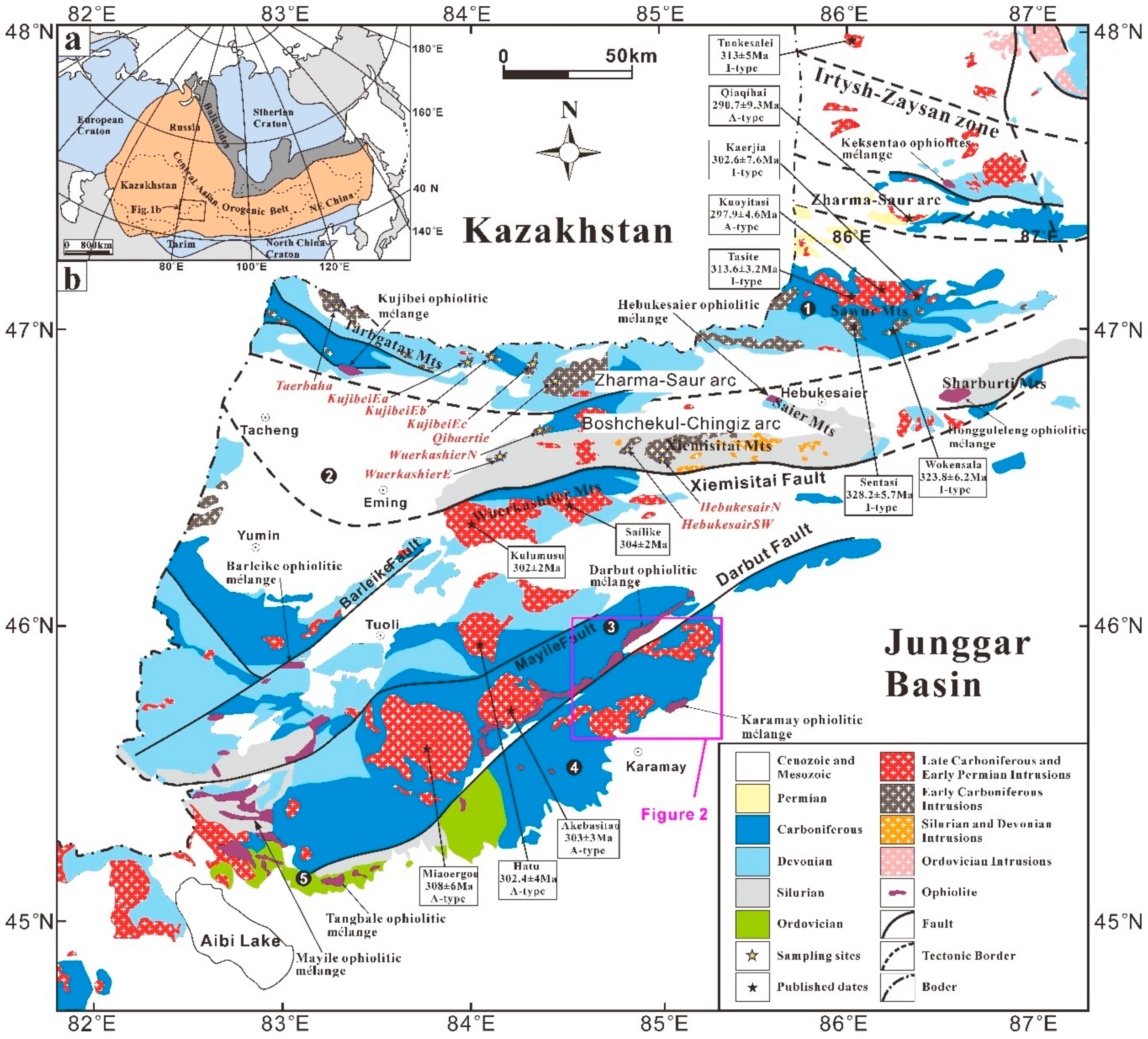
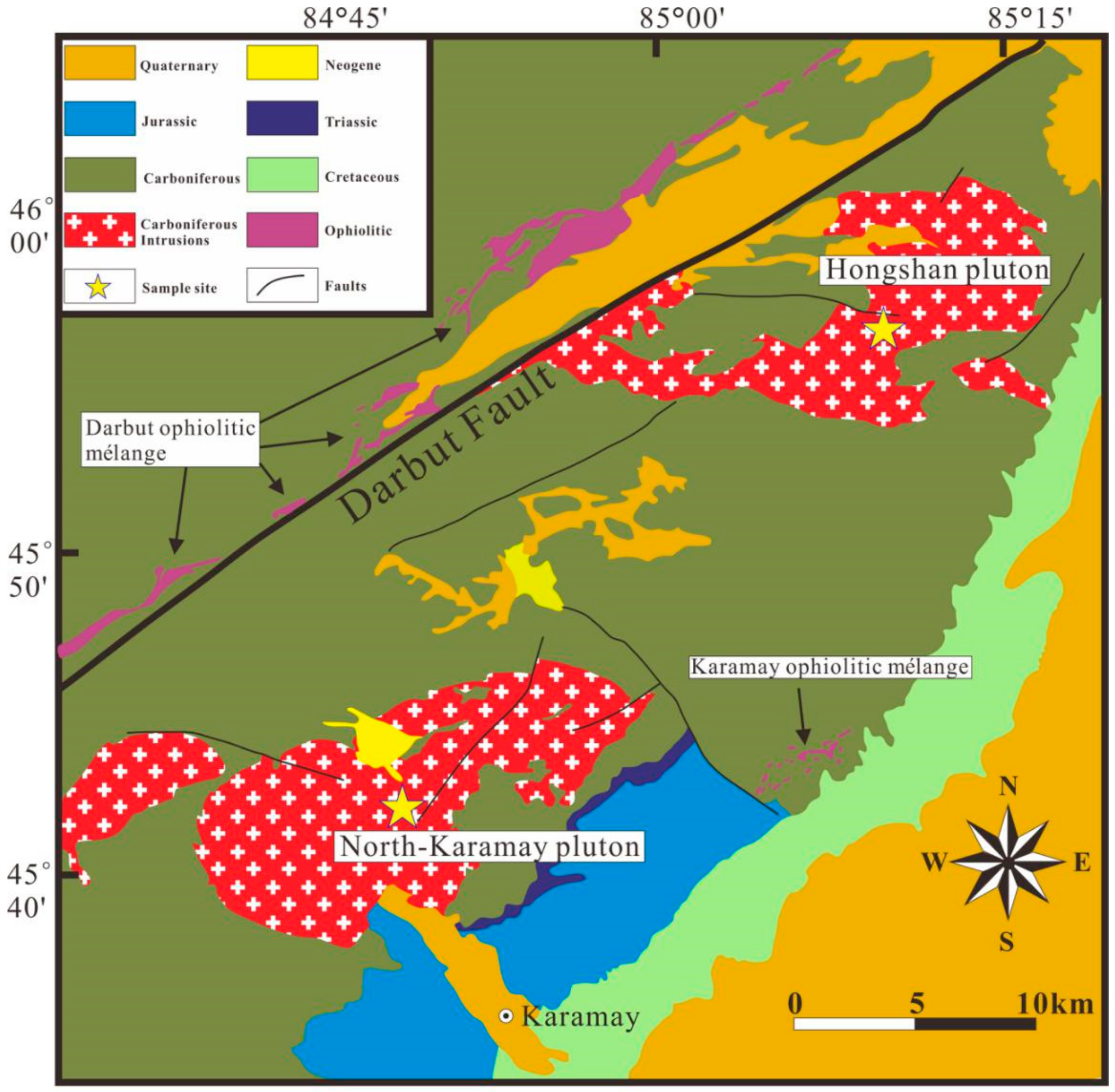
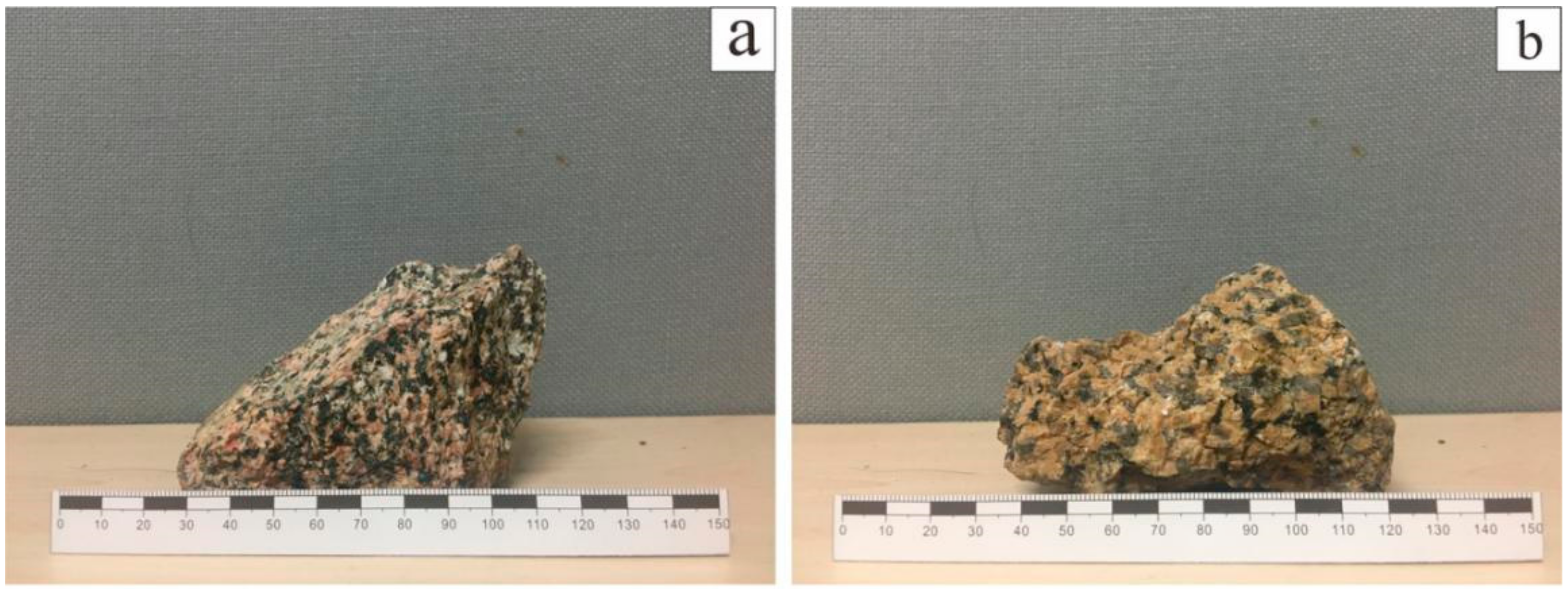
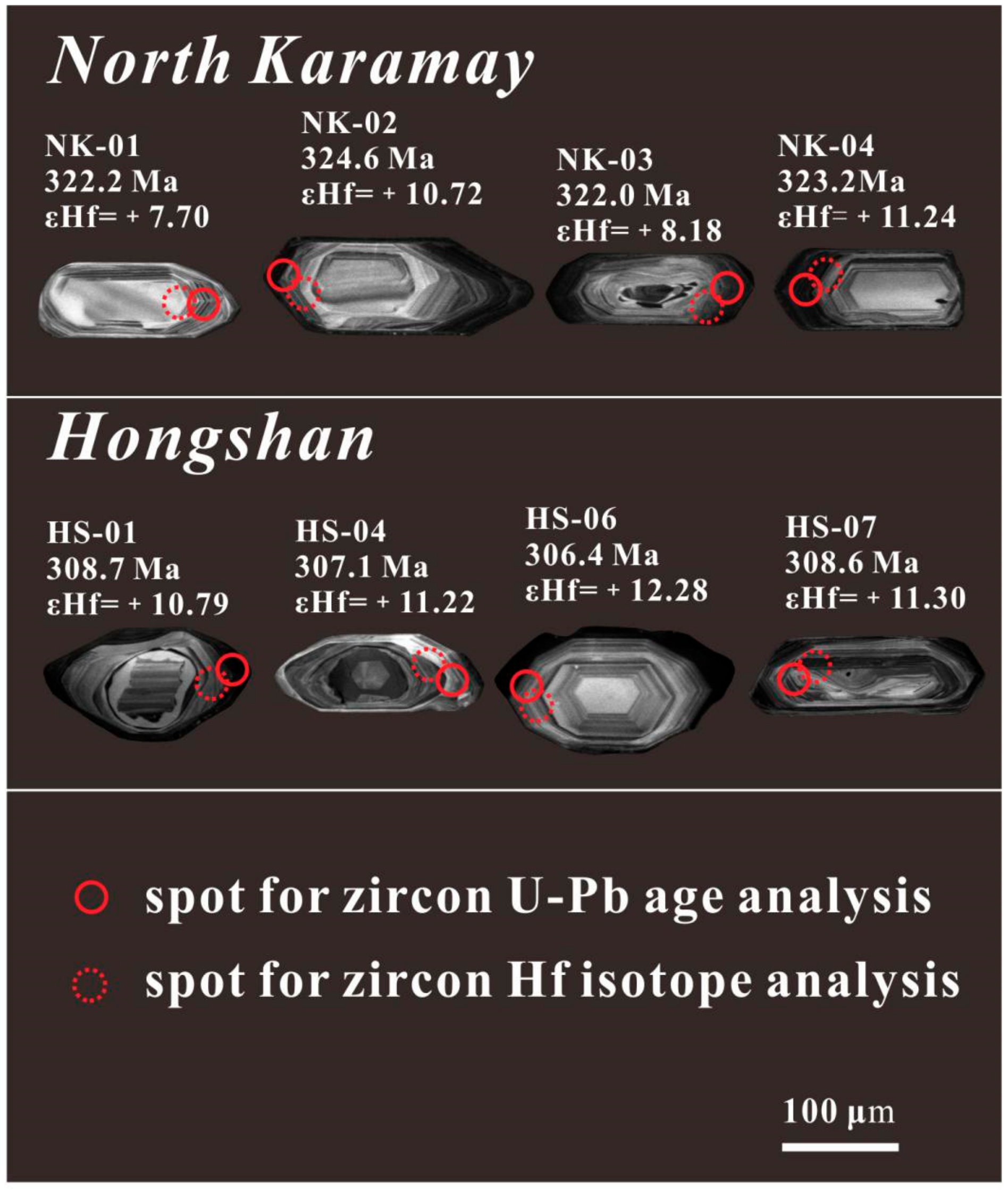

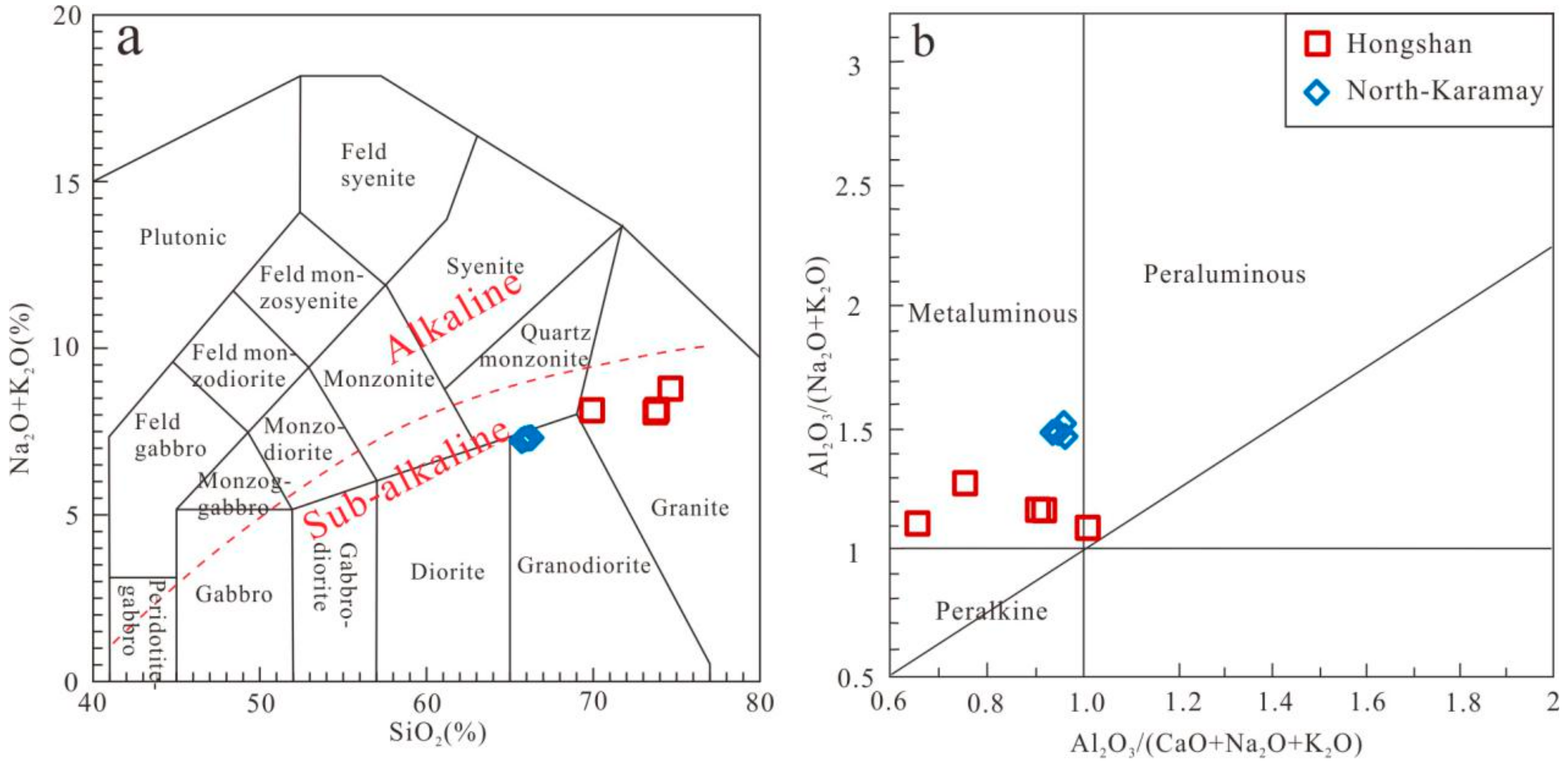
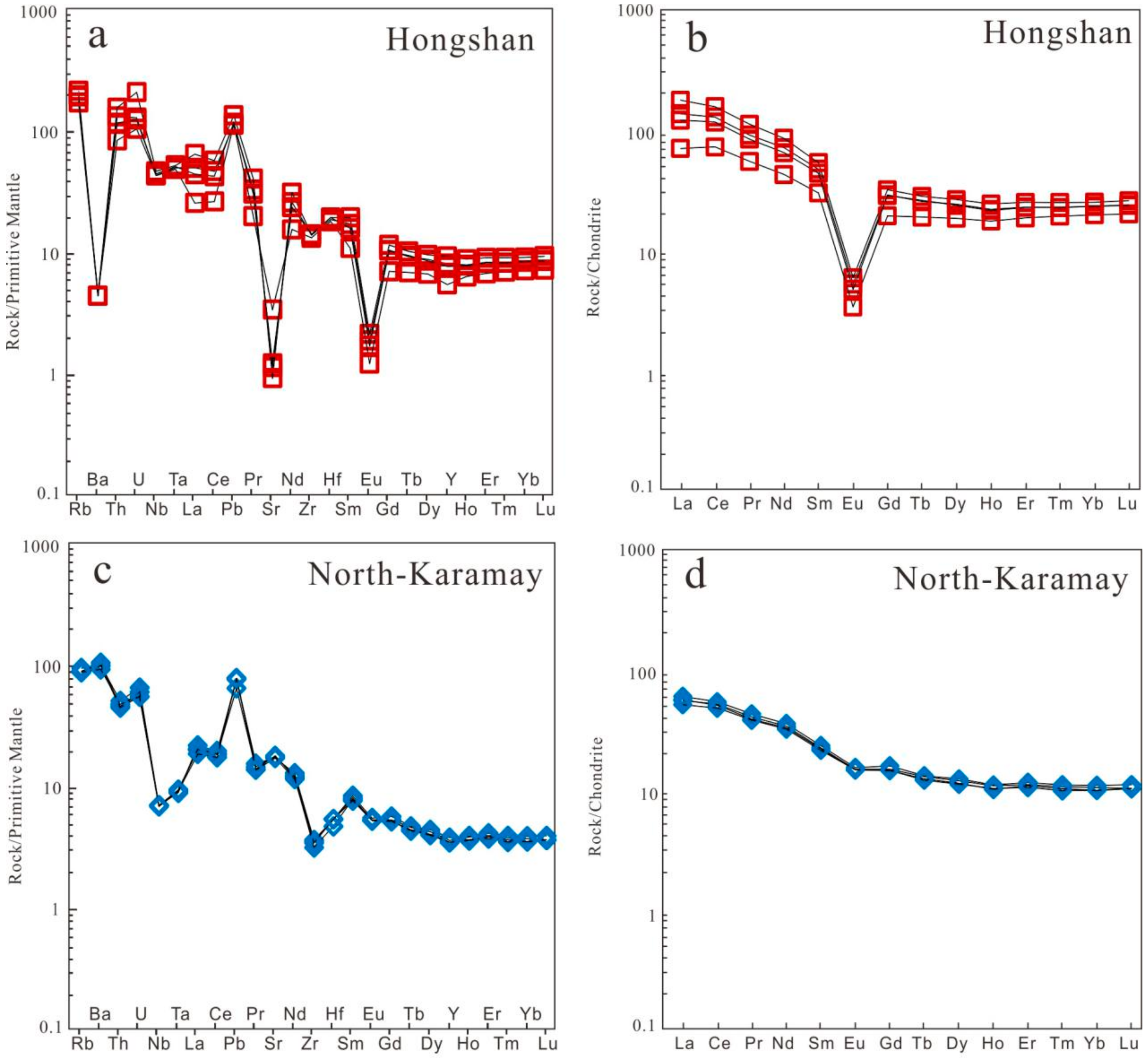
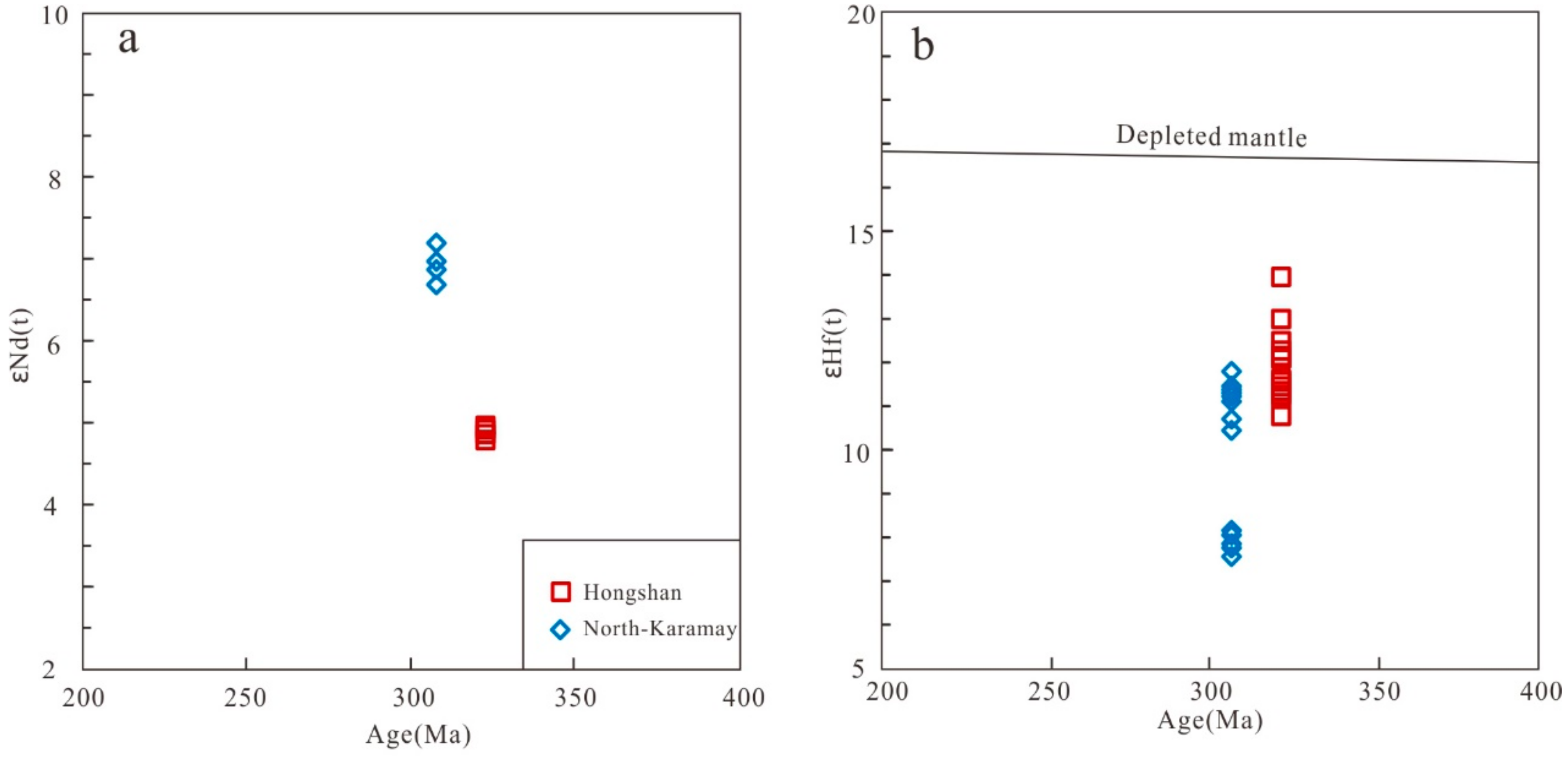
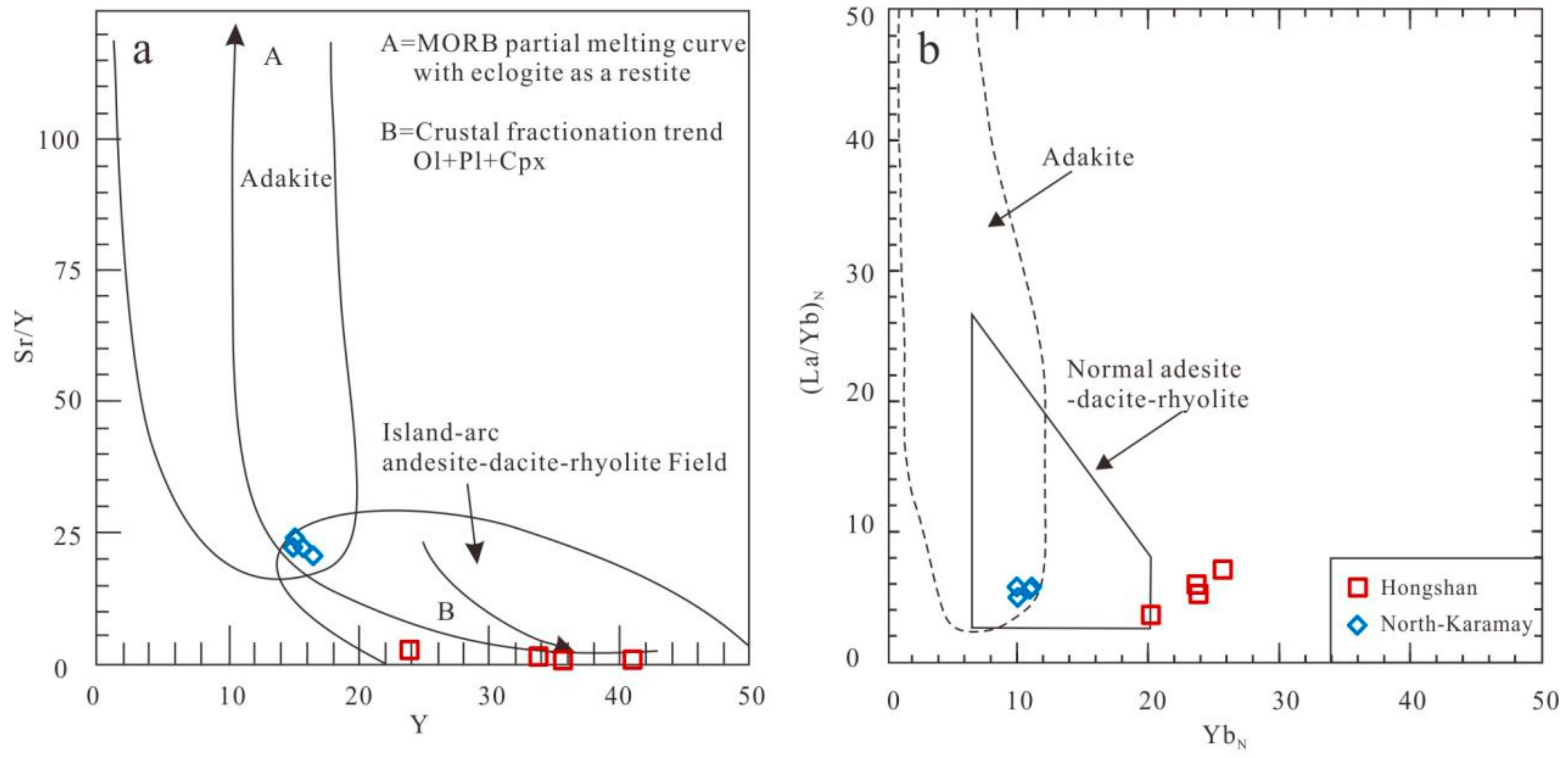
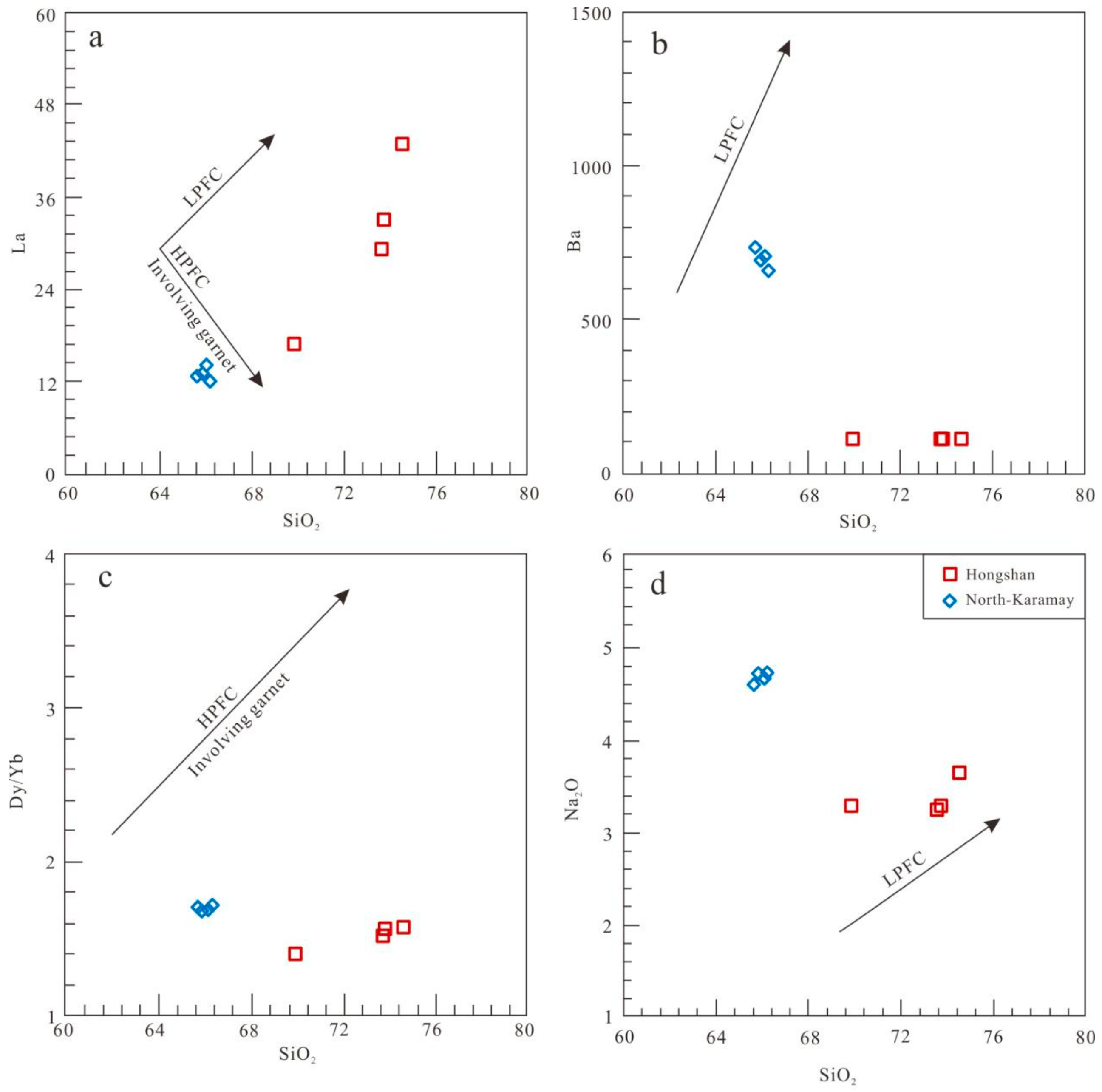

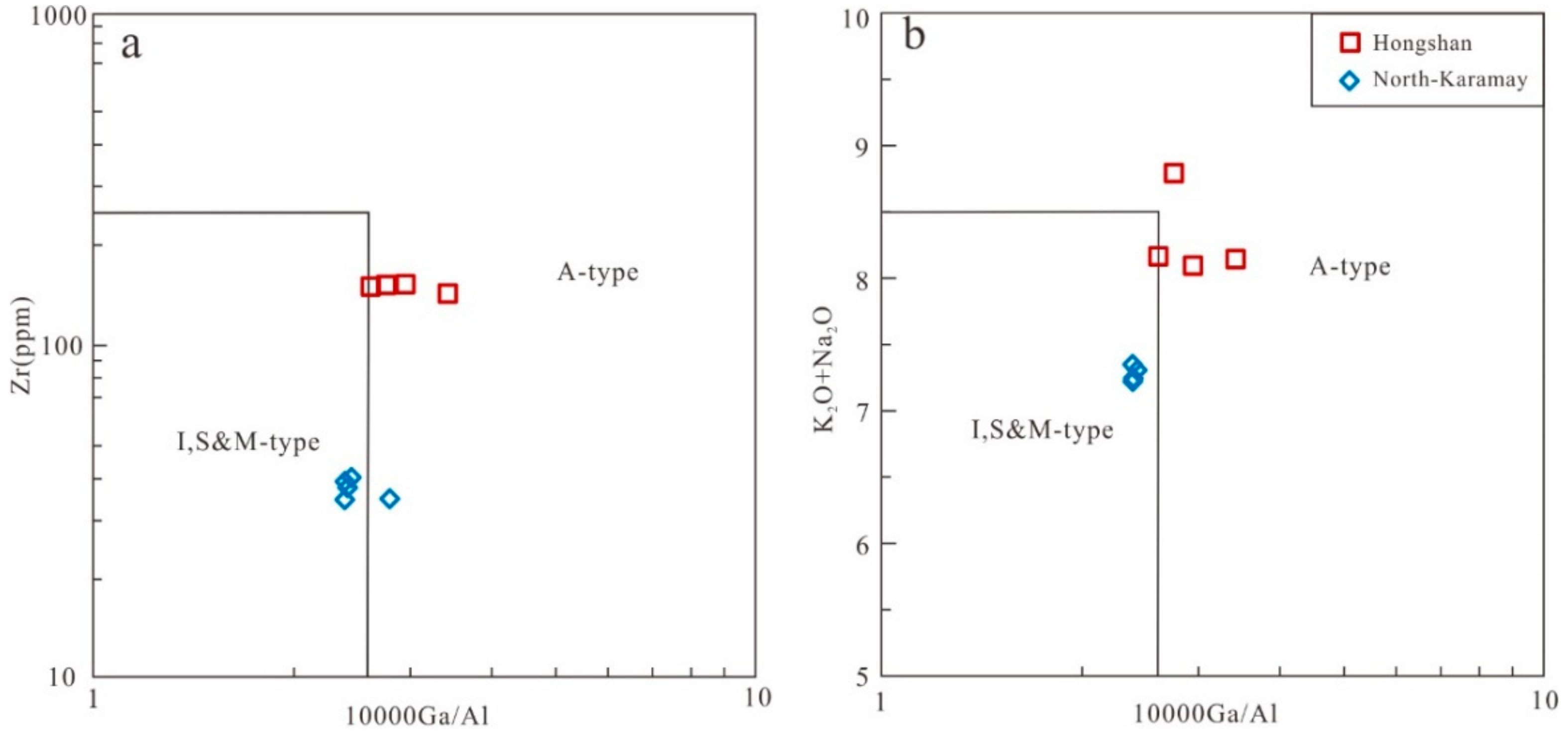
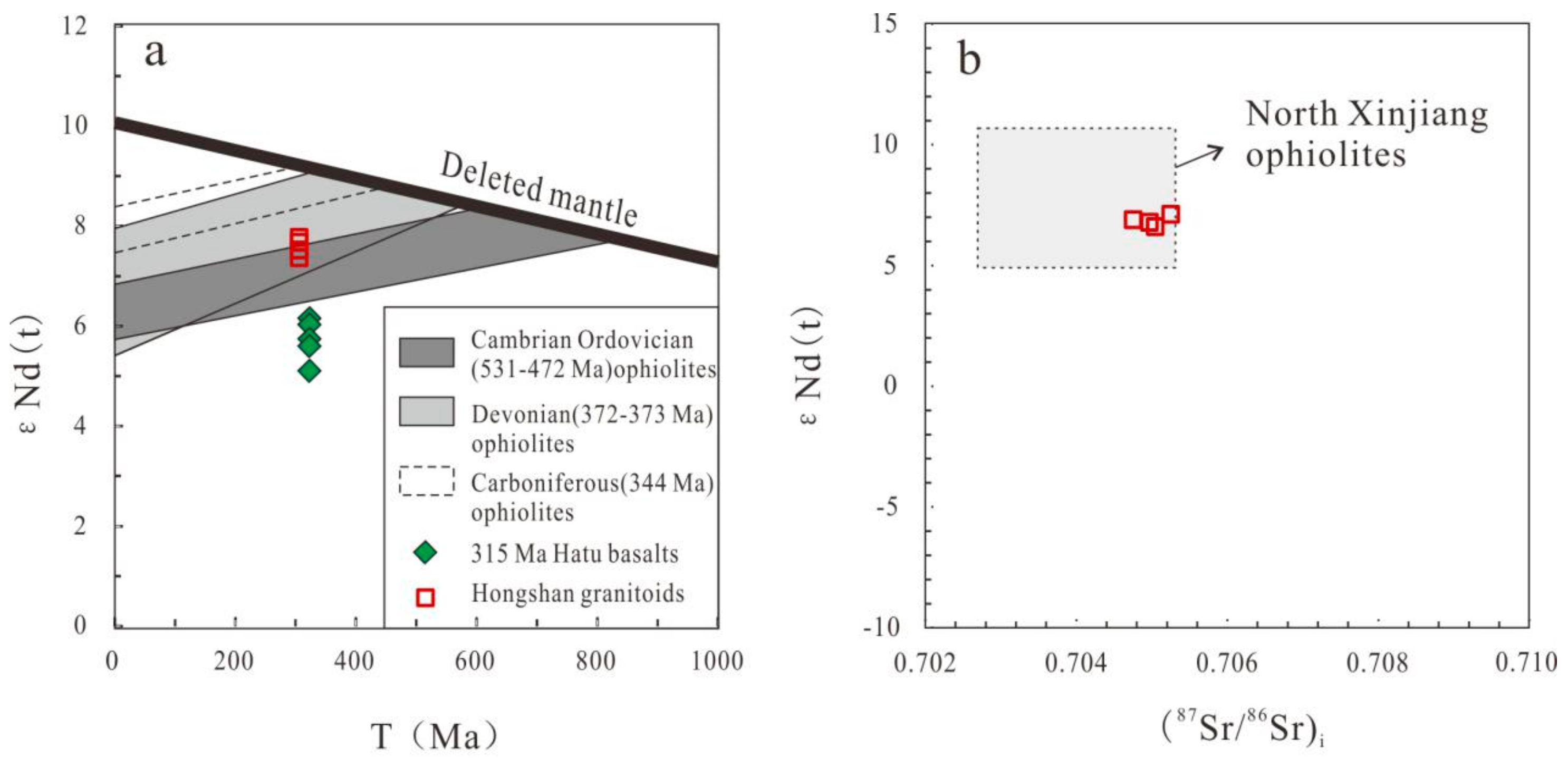
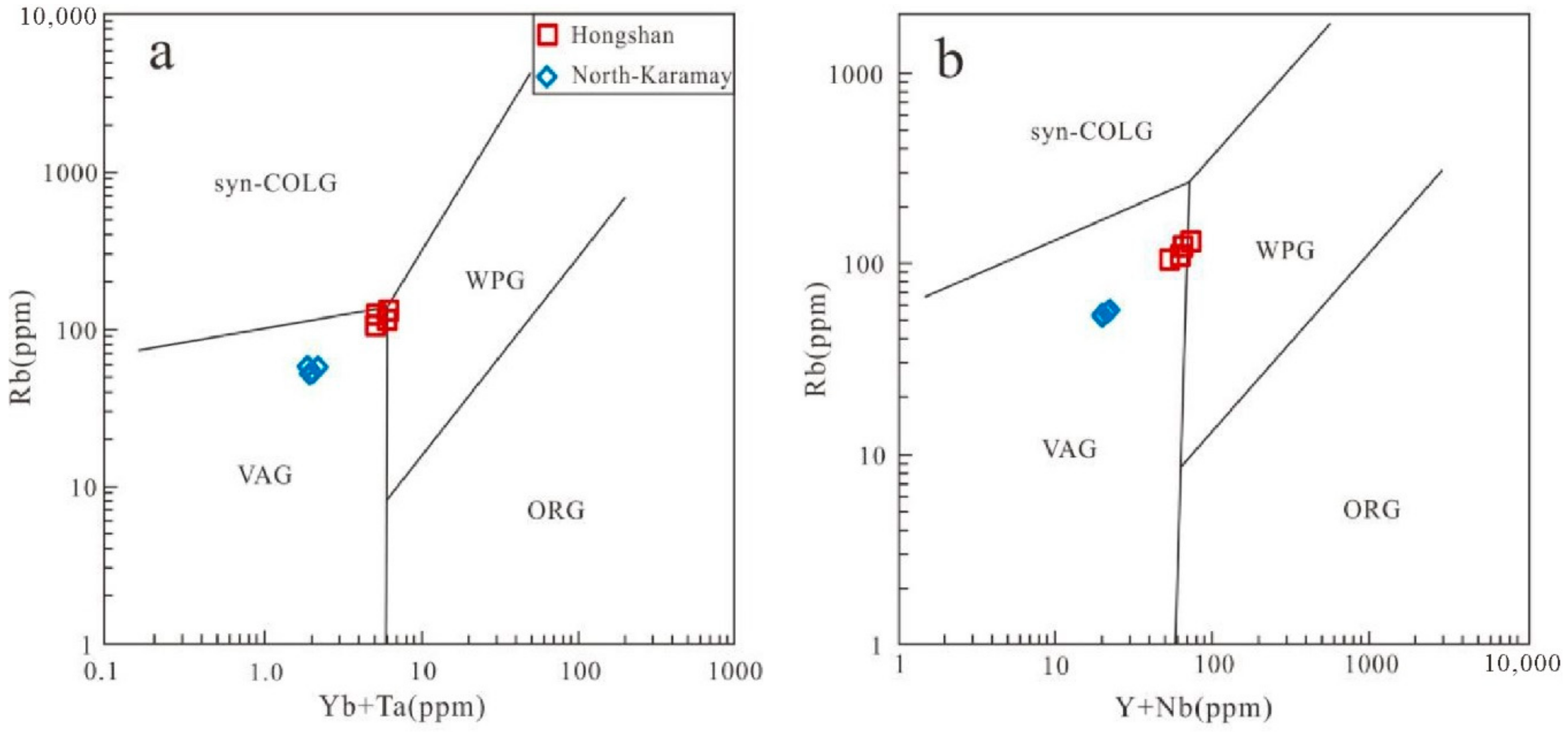
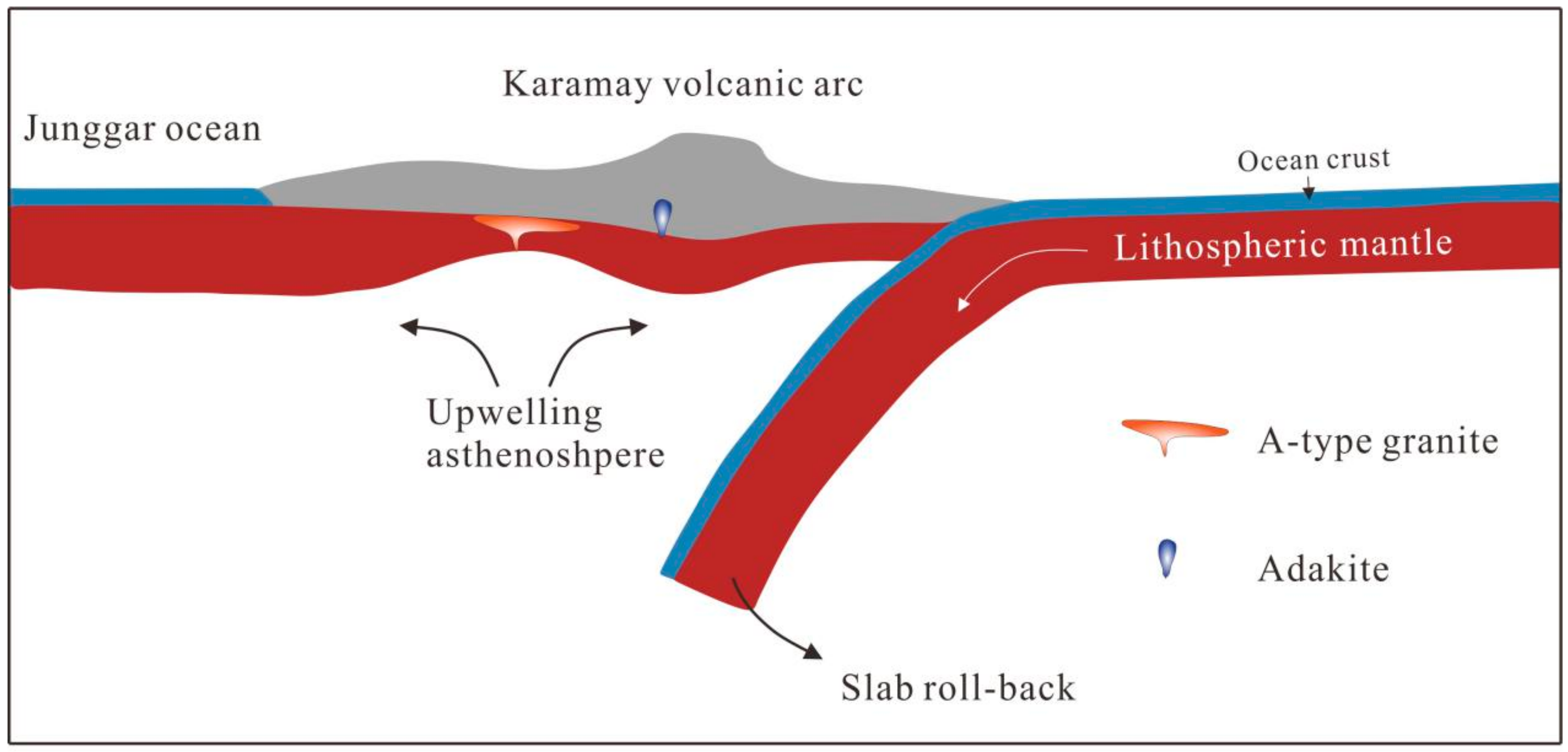
| Sample | Th/U | Ratio | Age (Ma) | ||||||||||
|---|---|---|---|---|---|---|---|---|---|---|---|---|---|
| 207Pb/206Pb | 1σ | 207Pb/235U | 1σ | 206Pb/238U | 1σ | 207Pb/206Pb | 1σ | 207Pb/235U | 1σ | 207Pb/238U | 1σ | ||
| NK-01 | 0.48 | 0.05793 | 0.00401 | 0.37660 | 0.01522 | 0.05133 | 0.00135 | 332 | 14 | 328 | 12 | 322 | 9 |
| NK-02 | 0.56 | 0.05543 | 0.00516 | 0.39083 | 0.01422 | 0.05172 | 0.00140 | 335 | 15 | 339 | 10 | 325 | 8 |
| NK-03 | 0.56 | 0.05674 | 0.00308 | 0.35436 | 0.01554 | 0.05122 | 0.00167 | 311 | 14 | 309 | 11 | 322 | 10 |
| NK-04 | 0.45 | 0.05371 | 0.00436 | 0.39214 | 0.01183 | 0.05141 | 0.00221 | 307 | 17 | 341 | 9 | 323 | 11 |
| NK-05 | 1.22 | 0.05620 | 0.00365 | 0.37741 | 0.01228 | 0.05113 | 0.00134 | 338 | 13 | 328 | 9 | 321 | 8 |
| NK-06 | 0.45 | 0.05962 | 0.00347 | 0.36680 | 0.01649 | 0.05129 | 0.00100 | 323 | 11 | 319 | 12 | 322 | 8 |
| NK-07 | 0.56 | 0.05642 | 0.00395 | 0.35945 | 0.01505 | 0.05092 | 0.00150 | 317 | 18 | 313 | 11 | 320 | 12 |
| NK-08 | 0.48 | 0.04817 | 0.00340 | 0.36678 | 0.01302 | 0.05122 | 0.00120 | 309 | 13 | 318 | 10 | 322 | 8 |
| NK-09 | 0.56 | 0.06071 | 0.00477 | 0.37263 | 0.01295 | 0.05109 | 0.00117 | 340 | 18 | 324 | 9 | 321 | 7 |
| NK-10 | 0.58 | 0.05304 | 0.00269 | 0.35749 | 0.01267 | 0.05143 | 0.00135 | 312 | 11 | 311 | 11 | 324 | 9 |
| NK-11 | 0.48 | 0.05601 | 0.00367 | 0.37690 | 0.00996 | 0.05144 | 0.00135 | 335 | 13 | 328 | 8 | 324 | 9 |
| NK-12 | 1.29 | 0.05778 | 0.00302 | 0.38116 | 0.01203 | 0.05136 | 0.00134 | 338 | 17 | 331 | 11 | 322 | 8 |
| NK-13 | 0.44 | 0.05226 | 0.00315 | 0.36803 | 0.01681 | 0.05157 | 0.00123 | 310 | 12 | 320 | 9 | 323 | 7 |
| NK-14 | 0.56 | 0.05246 | 0.00331 | 0.35096 | 0.01615 | 0.05147 | 0.00184 | 306 | 14 | 305 | 12 | 323 | 11 |
| NK-15 | 0.48 | 0.05373 | 0.00290 | 0.36580 | 0.01373 | 0.05151 | 0.00140 | 309 | 13 | 318 | 10 | 323 | 8 |
| NK-16 | 0.56 | 0.06201 | 0.00450 | 0.38188 | 0.01246 | 0.05189 | 0.00117 | 339 | 15 | 330 | 10 | 325 | 7 |
| NK-17 | 0.58 | 0.05276 | 0.00250 | 0.37210 | 0.01164 | 0.05139 | 0.00140 | 306 | 11 | 324 | 10 | 323 | 8 |
| NK-18 | 0.5 | 0.05826 | 0.00431 | 0.37573 | 0.01337 | 0.05180 | 0.00144 | 335 | 15 | 327 | 13 | 325 | 9 |
| NK-19 | 1.41 | 0.05624 | 0.00260 | 0.38288 | 0.01793 | 0.05165 | 0.00090 | 336 | 13 | 332 | 13 | 324 | 6 |
| NK-20 | 0.45 | 0.05083 | 0.00281 | 0.37144 | 0.01153 | 0.05143 | 0.00100 | 322 | 12 | 323 | 8 | 323 | 6 |
| NK-21 | 0.56 | 0.05195 | 0.00274 | 0.36601 | 0.01419 | 0.05160 | 0.00108 | 311 | 13 | 318 | 11 | 324 | 9 |
| NK-22 | 0.47 | 0.05267 | 0.00373 | 0.36695 | 0.00978 | 0.05109 | 0.00210 | 309 | 15 | 320 | 10 | 320 | 9 |
| NK-23 | 0.57 | 0.05723 | 0.00517 | 0.38022 | 0.01231 | 0.05146 | 0.00105 | 337 | 16 | 329 | 9 | 323 | 7 |
| NK-24 | 0.57 | 0.05191 | 0.00287 | 0.36345 | 0.01710 | 0.05124 | 0.00100 | 313 | 13 | 315 | 12 | 322 | 10 |
| NK-25 | 0.47 | 0.05555 | 0.00402 | 0.37931 | 0.01400 | 0.05125 | 0.00200 | 334 | 14 | 329 | 11 | 322 | 10 |
| NK-26 | 1.24 | 0.05926 | 0.00328 | 0.37074 | 0.01329 | 0.05065 | 0.00053 | 335 | 15 | 323 | 10 | 318 | 7 |
| NK-27 | 0.44 | 0.05371 | 0.00316 | 0.36528 | 0.02167 | 0.05152 | 0.00160 | 316 | 13 | 317 | 10 | 324 | 8 |
| NK-28 | 0.57 | 0.05410 | 0.00345 | 0.36126 | 0.01803 | 0.05089 | 0.00120 | 310 | 14 | 314 | 11 | 320 | 12 |
| NK-29 | 0.48 | 0.05510 | 0.00351 | 0.36536 | 0.01144 | 0.05141 | 0.00150 | 333 | 15 | 318 | 10 | 323 | 9 |
| NK-30 | 0.56 | 0.06185 | 0.00490 | 0.37612 | 0.00996 | 0.05116 | 0.00105 | 339 | 17 | 327 | 9 | 322 | 7 |
| NK-31 | 0.58 | 0.05441 | 0.00273 | 0.36198 | 0.01244 | 0.05140 | 0.00120 | 311 | 14 | 315 | 10 | 323 | 9 |
| NK-32 | 0.48 | 0.05554 | 0.02513 | 0.38276 | 0.02745 | 0.05134 | 0.00167 | 334 | 13 | 329 | 12 | 323 | 10 |
| NK-33 | 1.28 | 0.06239 | 0.01986 | 0.37584 | 0.03038 | 0.05139 | 0.00120 | 338 | 16 | 327 | 11 | 323 | 8 |
| NK-34 | 0.44 | 0.05642 | 0.02111 | 0.37108 | 0.01908 | 0.05127 | 0.00117 | 317 | 13 | 322 | 9 | 322 | 7 |
| NK-35 | 0.56 | 0.04817 | 0.02336 | 0.36220 | 0.02434 | 0.05162 | 0.00192 | 309 | 15 | 314 | 13 | 324 | 12 |
| HS-01 | 0.78 | 0.05589 | 0.00408 | 0.35507 | 0.01174 | 0.04943 | 0.00243 | 313 | 12 | 310 | 12 | 310 | 10 |
| HS-04 | 1.21 | 0.05287 | 0.00393 | 0.35785 | 0.01368 | 0.04901 | 0.00126 | 311 | 11 | 310 | 10 | 308 | 8 |
| HS-06 | 1.13 | 0.05250 | 0.00617 | 0.35496 | 0.01282 | 0.04879 | 0.00094 | 314 | 14 | 308 | 9 | 307 | 9 |
| HS-07 | 0.78 | 0.05385 | 0.00380 | 0.35815 | 0.01018 | 0.04927 | 0.00128 | 315 | 11 | 311 | 8 | 310 | 6 |
| HS-08 | 0.77 | 0.05209 | 0.00663 | 0.35312 | 0.01462 | 0.04884 | 0.00078 | 309 | 13 | 308 | 11 | 307 | 10 |
| HS-11 | 1.21 | 0.05349 | 0.00385 | 0.35565 | 0.01951 | 0.04876 | 0.00168 | 312 | 13 | 309 | 9 | 307 | 8 |
| HS-13 | 1.1 | 0.05477 | 0.00535 | 0.35854 | 0.01803 | 0.04923 | 0.00104 | 315 | 15 | 312 | 11 | 310 | 10 |
| HS-14 | 0.78 | 0.05707 | 0.00338 | 0.35461 | 0.00915 | 0.04896 | 0.00124 | 312 | 14 | 309 | 8 | 308 | 7 |
| HS-15 | 0.76 | 0.05379 | 0.00757 | 0.35615 | 0.01106 | 0.04887 | 0.00141 | 312 | 11 | 310 | 10 | 308 | 9 |
| HS-18 | 1.2 | 0.05461 | 0.00377 | 0.35697 | 0.01244 | 0.04895 | 0.00112 | 314 | 13 | 311 | 10 | 308 | 8 |
| HS-20 | 1.07 | 0.05239 | 0.00497 | 0.35907 | 0.02516 | 0.04905 | 0.00140 | 313 | 12 | 309 | 11 | 309 | 8 |
| HS-21 | 0.77 | 0.05020 | 0.00311 | 0.35589 | 0.02209 | 0.04910 | 0.00081 | 318 | 12 | 310 | 8 | 309 | 5 |
| HS-22 | 0.78 | 0.05245 | 0.00362 | 0.35799 | 0.02332 | 0.04930 | 0.00157 | 314 | 13 | 311 | 11 | 310 | 9 |
| HS-25 | 1.21 | 0.05403 | 0.00371 | 0.35833 | 0.01685 | 0.04901 | 0.00135 | 317 | 15 | 311 | 9 | 308 | 8 |
| HS-27 | 1.11 | 0.05332 | 0.00543 | 0.35626 | 0.00764 | 0.04878 | 0.00236 | 314 | 10 | 310 | 10 | 307 | 9 |
| HS-28 | 0.78 | 0.05158 | 0.00329 | 0.35395 | 0.01217 | 0.04895 | 0.00074 | 311 | 11 | 308 | 8 | 308 | 7 |
| HS-29 | 0.76 | 0.05239 | 0.00632 | 0.35721 | 0.00875 | 0.04910 | 0.00157 | 315 | 13 | 311 | 10 | 308 | 9 |
| HS-32 | 1.22 | 0.05607 | 0.00363 | 0.36046 | 0.00618 | 0.04894 | 0.00140 | 317 | 13 | 314 | 9 | 308 | 8 |
| HS-34 | 1.09 | 0.05354 | 0.00539 | 0.35640 | 0.00824 | 0.04892 | 0.00094 | 315 | 12 | 310 | 11 | 308 | 9 |
| HS-35 | 0.78 | 0.05252 | 0.00349 | 0.35598 | 0.01987 | 0.04892 | 0.00093 | 312 | 13 | 310 | 10 | 307 | 7 |
| Sample Number | NK-01 | NK-02 | NK-03 | NK-04 | HS-01 | HS-02 | HS-03 | HS-04 |
|---|---|---|---|---|---|---|---|---|
| SiO2 | 65.90 | 66.29 | 66.13 | 65.71 | 69.95 | 73.77 | 73.87 | 74.66 |
| Al2O3 | 16.17 | 15.85 | 15.78 | 15.73 | 12.02 | 12.54 | 12.63 | 12.84 |
| TFe2O3 | 4.36 | 4.48 | 4.55 | 4.78 | 1.40 | 1.47 | 1.07 | 1.36 |
| MgO | 1.48 | 1.48 | 1.55 | 1.55 | 0.15 | 0.18 | 0.17 | 0.13 |
| CaO | 3.39 | 3.29 | 3.40 | 3.29 | 4.17 | 1.72 | 1.62 | 0.57 |
| Na2O | 4.72 | 4.73 | 4.67 | 4.60 | 3.28 | 3.26 | 3.28 | 3.64 |
| K2O | 2.57 | 2.60 | 2.64 | 2.65 | 4.87 | 4.84 | 4.89 | 5.16 |
| MnO | 0.11 | 0.11 | 0.11 | 0.12 | 0.10 | 0.08 | 0.06 | 0.02 |
| P2O5 | 0.15 | 0.15 | 0.16 | 0.15 | 0.01 | 0.01 | 0.01 | 0.01 |
| TiO2 | 0.55 | 0.57 | 0.58 | 0.57 | 0.18 | 0.20 | 0.20 | 0.20 |
| LOI | 0.67 | 0.59 | 0.67 | 0.65 | 3.83 | 1.88 | 1.89 | 0.77 |
| Total | 100.20 | 100.26 | 100.37 | 99.92 | 99.98 | 99.95 | 99.69 | 99.36 |
| A/CNK | 0.97 | 0.96 | 0.94 | 0.96 | 0.66 | 0.91 | 0.93 | 1.02 |
| A/NK | 1.53 | 1.49 | 1.50 | 1.51 | 1.13 | 1.18 | 1.18 | 1.11 |
| Mg# | 0.38 | 0.37 | 0.38 | 0.37 | 0.16 | 0.18 | 0.22 | 0.15 |
| K2O + Na2O | 4.87 | 4.88 | 4.83 | 4.75 | 3.29 | 3.27 | 3.29 | 3.65 |
| Na2O/K2O | 0.03 | 0.03 | 0.03 | 0.03 | 0.00 | 0.00 | 0.00 | 0.00 |
| Sample Number | NK-01 | NK-02 | NK-03 | NK-04 | HS-01 | HS-02 | HS-03 | HS-04 |
|---|---|---|---|---|---|---|---|---|
| Li | 13.1 | 12.5 | 15.2 | 16.6 | 18.3 | 22.9 | 22.4 | 26.0 |
| Be | 1.17 | 1.25 | 1.28 | 1.23 | 3.87 | 4.03 | 3.86 | 4.23 |
| Sc | 8.4 | 9.5 | 9.6 | 9.3 | 3.2 | 3.8 | 3.9 | 4.3 |
| V | 64 | 66 | 67 | 68 | 4 | 4 | 4 | 3 |
| Cr | 17 | 17 | 19 | 16 | 6 | 4 | 6 | 6 |
| Co | 7.6 | 7.5 | 7.9 | 8.1 | 0.2 | 0.2 | 0.2 | 0.3 |
| Ni | 5.9 | 6.3 | 6.1 | 6.6 | 0.5 | 0.5 | 0.8 | 0.9 |
| Cu | 19.7 | 18.3 | 21.7 | 22.3 | 0.9 | 1.3 | 0.8 | 0.8 |
| Zn | 68 | 71 | 78 | 79 | 40 | 43 | 33 | 28 |
| Ga | 18.10 | 17.95 | 18.35 | 17.90 | 15.50 | 17.05 | 16.60 | 17.75 |
| Ge | 0.22 | 0.26 | 0.26 | 0.25 | 0.16 | 0.17 | 0.16 | 0.16 |
| As | 6.8 | 7.2 | 9.9 | 10.2 | 4.2 | 4.2 | 2.4 | 4.3 |
| Rb | 53.9 | 52.5 | 56.8 | 53.2 | 104.5 | 120.1 | 122.5 | 137.5 |
| Sr | 362 | 347 | 348 | 357 | 69.6 | 25.3 | 23.5 | 19.1 |
| Y | 15.3 | 15.3 | 16.7 | 15.8 | 24.1 | 33.9 | 35.7 | 41.1 |
| Zr | 34.1 | 37.1 | 39.2 | 38.2 | 143.5 | 153.0 | 150.5 | 152.5 |
| Nb | 4.8 | 4.7 | 4.8 | 4.8 | 29.6 | 30.6 | 29.7 | 32.0 |
| Mo | 1.35 | 1.15 | 1.42 | 1.27 | 2.79 | 2.72 | 2.64 | 3.05 |
| Ag | 0.06 | 0.07 | 0.08 | 0.10 | 0.03 | 0.01 | <0.01 | <0.01 |
| Cd | 0.08 | 0.20 | 0.14 | 0.15 | 0.05 | 0.03 | 0.03 | 0.05 |
| In | 0.049 | 0.065 | 0.071 | 0.072 | 0.066 | 0.073 | 0.064 | 0.064 |
| Sb | 0.57 | 0.88 | 1.03 | 0.81 | 1.54 | 1.39 | 1.22 | 1.33 |
| Cs | 1.58 | 1.99 | 1.52 | 1.59 | 1.47 | 1.74 | 1.68 | 2.05 |
| Ba | 650 | 610 | 660 | 690 | 30 | 30 | 30 | 30 |
| La | 13.4 | 12.2 | 14.3 | 13.2 | 17.0 | 29.2 | 33.0 | 42.7 |
| Ce | 31.1 | 29.5 | 33.3 | 31.8 | 45.1 | 72.6 | 80.0 | 97.5 |
| Pr | 3.68 | 3.63 | 4.08 | 3.84 | 5.31 | 8.13 | 8.80 | 10.80 |
| Nd | 15.4 | 15.0 | 16.7 | 15.9 | 20.3 | 30.9 | 33.9 | 40.6 |
| Sm | 3.35 | 3.27 | 3.58 | 3.43 | 4.68 | 6.81 | 7.38 | 8.36 |
| Eu | 0.85 | 0.85 | 0.89 | 0.86 | 0.20 | 0.28 | 0.31 | 0.35 |
| Gd | 2.98 | 2.97 | 3.25 | 3.05 | 4.05 | 5.98 | 6.05 | 6.67 |
| Tb | 0.45 | 0.46 | 0.49 | 0.48 | 0.72 | 0.99 | 0.97 | 1.07 |
| Dy | 2.83 | 2.88 | 3.13 | 3.01 | 4.78 | 6.12 | 6.26 | 6.83 |
| Ho | 0.58 | 0.57 | 0.62 | 0.61 | 1.01 | 1.24 | 1.26 | 1.40 |
| Er | 1.73 | 1.79 | 1.91 | 1.83 | 3.14 | 3.84 | 3.86 | 4.22 |
| Tm | 0.25 | 0.26 | 0.28 | 0.27 | 0.50 | 0.59 | 0.59 | 0.65 |
| Yb | 1.68 | 1.68 | 1.85 | 1.77 | 3.42 | 4.04 | 4.01 | 4.35 |
| Lu | 0.26 | 0.26 | 0.28 | 0.26 | 0.52 | 0.61 | 0.62 | 0.67 |
| Hf | 1.4 | 1.6 | 1.6 | 1.6 | 5.4 | 5.8 | 5.6 | 5.8 |
| Ta | 0.36 | 0.36 | 0.35 | 0.37 | 1.92 | 2.01 | 1.97 | 2.06 |
| W | 15.7 | 16.5 | 16.3 | 15.3 | 1.3 | 1.2 | 1.3 | 1.3 |
| Tl | 0.19 | 0.18 | 0.20 | 0.20 | 0.55 | 0.53 | 0.51 | 0.62 |
| Pb | 11.3 | 13.7 | 13.4 | 13.6 | 20.0 | 20.8 | 20.0 | 23.9 |
| Bi | 0.10 | 0.11 | 0.13 | 0.13 | 0.04 | 0.03 | 0.03 | 0.02 |
| Th | 3.61 | 3.85 | 4.10 | 3.71 | 6.84 | 9.54 | 10.75 | 12.70 |
| U | 1.1 | 1.1 | 1.3 | 1.2 | 2.1 | 2.5 | 2.6 | 4.2 |
| Sample | 87Rb/86Sr | 87Sr/86Sr | 2σ | (87Sr/86Sr)i | 147Sm/144Nd | 143Nd/144Nd | 2σ | (143Nd/144Nd)i | fSm/Nd | εNd(t) | TDM1(Ma) | TDM2(Ma) |
|---|---|---|---|---|---|---|---|---|---|---|---|---|
| HS-01 | 4.350 | 0.721765 | 2 | 0.705055 | 0.1394 | 0.512866 | 3 | 0.512574 | −0.26 | 6.70 | 583 | 490 |
| HS-02 | 13.802 | 0.757996 | 4 | 0.704978 | 0.1332 | 0.512863 | 2 | 0.512584 | −0.29 | 6.88 | 544 | 477 |
| HS-03 | 15.163 | 0.763008 | 3 | 0.704760 | 0.1316 | 0.512865 | 4 | 0.512590 | −0.30 | 6.98 | 530 | 470 |
| HS-04 | 20.988 | 0.785883 | 5 | 0.705262 | 0.1245 | 0.512862 | 2 | 0.512601 | −0.34 | 7.21 | 493 | 454 |
| NK-01 | 0.431 | 0.702923 | 3 | 0.701269 | 0.1315 | 0.512751 | 2 | 0.512462 | −0.30 | 4.89 | 741 | 628 |
| NK-02 | 0.438 | 0.702613 | 3 | 0.700932 | 0.1318 | 0.512748 | 2 | 0.512459 | −0.30 | 4.82 | 749 | 633 |
| NK-03 | 0.472 | 0.702725 | 4 | 0.700912 | 0.1296 | 0.512750 | 1 | 0.512465 | −0.31 | 4.95 | 726 | 624 |
| NK-04 | 0.431 | 0.702846 | 2 | 0.701191 | 0.1304 | 0.512747 | 4 | 0.512461 | −0.31 | 4.86 | 738 | 630 |
| Sample Name | 176Hf/177Hf | 1s | 176Yb/177Hf | 1s | 176Lu/177Hf | 1s | ɛHf(t) | TDM1(Ma) | TDM2(Ma) |
|---|---|---|---|---|---|---|---|---|---|
| NK-01 | 0.282799 | 0.000010 | 0.003157 | 0.000013 | 0.001557 | 0.000012 | 7.70 | 651.95 | 839.27 |
| NK-02 | 0.282881 | 0.000012 | 0.010279 | 0.000086 | 0.001104 | 0.000010 | 10.72 | 526.83 | 647.06 |
| NK-03 | 0.282812 | 0.000009 | 0.000857 | 0.000001 | 0.001506 | 0.000024 | 8.18 | 632.07 | 808.79 |
| NK-04 | 0.282903 | 0.000010 | 0.010384 | 0.000010 | 0.002314 | 0.000012 | 11.24 | 512.06 | 613.87 |
| NK-05 | 0.282877 | 0.000009 | 0.010834 | 0.000026 | 0.001627 | 0.000035 | 10.46 | 540.08 | 663.25 |
| NK-06 | 0.282804 | 0.000014 | 0.014430 | 0.000108 | 0.001130 | 0.000001 | 7.98 | 637.08 | 821.68 |
| NK-07 | 0.282902 | 0.000010 | 0.014609 | 0.000020 | 0.001345 | 0.000006 | 11.39 | 501.10 | 604.40 |
| NK-08 | 0.282909 | 0.000011 | 0.011777 | 0.000118 | 0.000538 | 0.000044 | 11.80 | 480.78 | 577.79 |
| NK-09 | 0.282797 | 0.000011 | 0.003129 | 0.000012 | 0.001603 | 0.000011 | 7.61 | 656.05 | 845.06 |
| NK-10 | 0.282879 | 0.000013 | 0.010190 | 0.000079 | 0.001744 | 0.000009 | 10.50 | 539.31 | 660.96 |
| NK-11 | 0.282810 | 0.000010 | 0.000850 | 0.000001 | 0.001630 | 0.000023 | 8.07 | 637.50 | 815.65 |
| NK-12 | 0.282901 | 0.000011 | 0.010293 | 0.000009 | 0.001182 | 0.000011 | 11.40 | 499.85 | 603.65 |
| NK-13 | 0.282875 | 0.000010 | 0.010740 | 0.000024 | 0.001176 | 0.000033 | 10.48 | 536.85 | 662.30 |
| NK-14 | 0.282802 | 0.000015 | 0.014305 | 0.000099 | 0.001294 | 0.000001 | 7.86 | 643.17 | 829.10 |
| NK-15 | 0.282899 | 0.000011 | 0.014482 | 0.000018 | 0.001337 | 0.000006 | 11.31 | 504.29 | 609.48 |
| HS-01 | 0.282922 | 0.000013 | 0.037394 | 0.005785 | 0.006269 | 0.000164 | 10.79 | 543.65 | 630.70 |
| HS-02 | 0.282936 | 0.000014 | 0.089796 | 0.001938 | 0.002100 | 0.000064 | 12.12 | 461.67 | 545.92 |
| HS-03 | 0.282927 | 0.000012 | 0.055288 | 0.004316 | 0.004677 | 0.000129 | 11.30 | 510.09 | 598.51 |
| HS-04 | 0.282904 | 0.000011 | 0.025720 | 0.000932 | 0.001010 | 0.000027 | 11.22 | 493.25 | 603.32 |
| HS-05 | 0.282900 | 0.000011 | 0.036632 | 0.000383 | 0.000415 | 0.000014 | 11.21 | 490.74 | 603.96 |
| HS-06 | 0.282940 | 0.000013 | 0.049781 | 0.001850 | 0.002005 | 0.000063 | 12.28 | 454.88 | 536.02 |
| HS-07 | 0.282916 | 0.000010 | 0.055865 | 0.002550 | 0.002763 | 0.000082 | 11.30 | 499.03 | 598.23 |
| HS-08 | 0.282922 | 0.000012 | 0.080882 | 0.000751 | 0.000813 | 0.000032 | 11.90 | 465.11 | 559.86 |
| HS-09 | 0.282918 | 0.000011 | 0.060288 | 0.002136 | 0.002314 | 0.000066 | 11.46 | 490.18 | 588.30 |
| HS-10 | 0.282921 | 0.000011 | 0.031263 | 0.002120 | 0.002298 | 0.000064 | 11.57 | 485.34 | 580.99 |
| HS-11 | 0.282916 | 0.000010 | 0.019363 | 0.002198 | 0.002382 | 0.000066 | 11.35 | 495.05 | 595.23 |
| HS-12 | 0.282934 | 0.000013 | 0.026723 | 0.001571 | 0.001703 | 0.000053 | 12.15 | 459.01 | 544.37 |
| HS-13 | 0.282980 | 0.000012 | 0.087979 | 0.000698 | 0.000756 | 0.000056 | 13.96 | 383.01 | 428.75 |
| HS-14 | 0.282944 | 0.000012 | 0.025627 | 0.001611 | 0.001746 | 0.000054 | 12.49 | 445.13 | 522.45 |
| HS-15 | 0.282960 | 0.000012 | 0.031248 | 0.001811 | 0.001963 | 0.000024 | 13.00 | 425.09 | 490.11 |
© 2020 by the authors. Licensee MDPI, Basel, Switzerland. This article is an open access article distributed under the terms and conditions of the Creative Commons Attribution (CC BY) license (http://creativecommons.org/licenses/by/4.0/).
Share and Cite
Lu, J.; Zhang, C.; Liu, D. Geochronological, Geochemical and Sr-Nd-Hf Isotopic Studies of the A-type Granites and Adakitic Granodiorites in Western Junggar: Petrogenesis and Tectonic Implications. Minerals 2020, 10, 397. https://doi.org/10.3390/min10050397
Lu J, Zhang C, Liu D. Geochronological, Geochemical and Sr-Nd-Hf Isotopic Studies of the A-type Granites and Adakitic Granodiorites in Western Junggar: Petrogenesis and Tectonic Implications. Minerals. 2020; 10(5):397. https://doi.org/10.3390/min10050397
Chicago/Turabian StyleLu, Jia, Chen Zhang, and Dongdong Liu. 2020. "Geochronological, Geochemical and Sr-Nd-Hf Isotopic Studies of the A-type Granites and Adakitic Granodiorites in Western Junggar: Petrogenesis and Tectonic Implications" Minerals 10, no. 5: 397. https://doi.org/10.3390/min10050397
APA StyleLu, J., Zhang, C., & Liu, D. (2020). Geochronological, Geochemical and Sr-Nd-Hf Isotopic Studies of the A-type Granites and Adakitic Granodiorites in Western Junggar: Petrogenesis and Tectonic Implications. Minerals, 10(5), 397. https://doi.org/10.3390/min10050397





